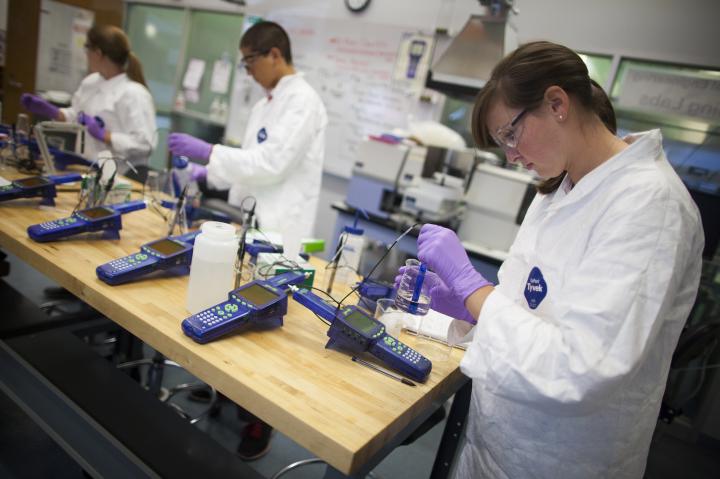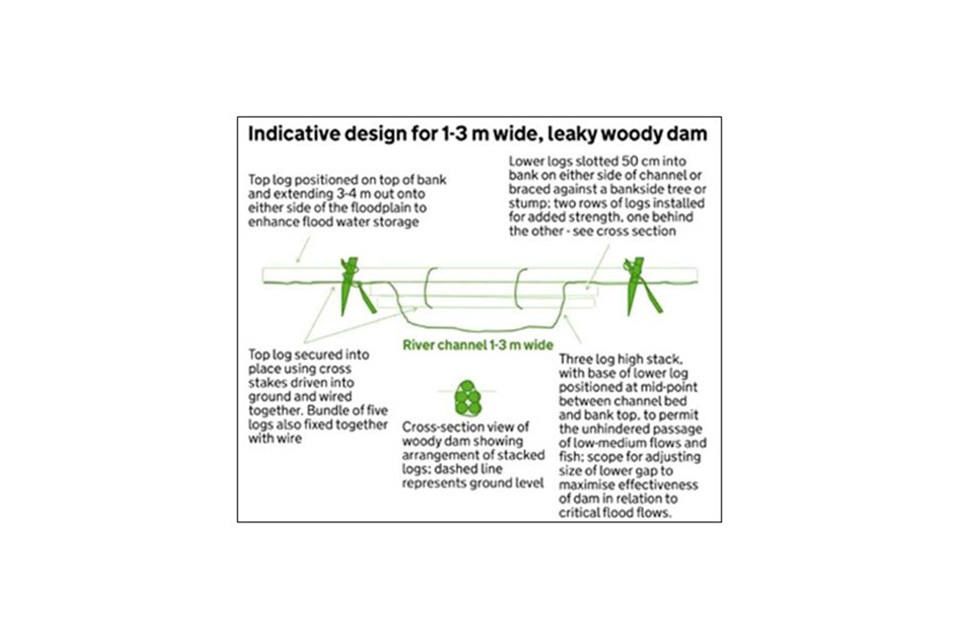

Find Funded Projects and More Using NIH Databases
Staying at the cutting edge involves more than just keeping up with the journals and attending scientific conferences. You can leverage NIH databases to learn about emerging research in your field, find potential collaborators for future projects, identify promising research areas, and much more.
Use the tips and links on this page to explore these free NIH databases:
- Research Portfolio Online Reporting Tools (RePORT) —find historic and current data on all NIH-supported grants, contracts, and award recipients.
- ClinicalTrials.gov —search for summaries and details of NIH-funded clinical trials.
- More Data Sources —check PubMed, eRA Commons, and more.
Research Portfolio Online Reporting Tools (RePORT)
NIH’s Research Portfolio Online Reporting Tools (RePORT) displays interactive charts, reports, and tables of historic and current data on grants, contracts, and award recipients.
RePORT has the following five major sections:
1. RePORT Expenditures and Results (RePORTER)
RePORT Expenditures and Results (RePORTER) to customize queries on funded projects, investigators, publications, and patents. This can be a great way to get a snapshot of research areas in your field and look for potential collaborators or competitors. You may spot research areas that are underrepresented or highly supported.
Try the Quick Search field or Advanced Project Search . Your search results include tabs to check Publications and more.
Export and share your search results, save MyRePORTER queries, or download raw data through ExPORTER . Advanced users can retrieve data for analysis and/or reuse in other applications through the RePORTER Application Programming Interface (API) .
2. Matchmaker
Matchmaker allows you to enter scientific text (e.g., an abstract) and find similar projects or NIH program officers:
- The Similar Projects option helps you find potential collaborators or determine which NIH institute and study section your application could target. (Note that Special Emphasis Panel labels start with a “Z”. You cannot request assignment to a SEP.)
- The Similar Program Officials option lists relevant NIH institutes and program officers.
3. Awards by Location and Organization
Check RePORT’s NIH Awards by Location and Organization for year-by-year NIH funding by institution, state, congressional district, principal investigator, funding mechanism, and more. Similar to the options above, you can use this to find collaborators and evaluate support for your area of science.
4. Categorical Spending (RCDC)
The Categorical Spending option on the RePORT main page brings you to the Estimates of Funding for Various Research, Condition, and Disease Categories (RCDC) section.
RCDC shows you the annual support level for each category of research. NIH determines the category for each project based on application text. RCDC includes historic data since fiscal year (FY) 2008 and projections for the current FY.
5. NIH Data Book
The NIH Data Book section of RePORT offers interactive charts and reports on extramural grants and contracts, awardee organizations, and the national biomedical workforce. Most reports include controls to fine tune the details and dates displayed. You can also use the Data, Export, and View More options.
Learn more about RePORT in the Frequently Asked Questions . Direct your feedback, corrections, or questions to RePORT General Inquiries .
ClinicalTrials.gov
Search public information about NIH-funded clinical trials at ClinicalTrials.gov . Use it to find other researchers’ projects, uncover new developments in clinical research, and find potential collaborators.
Note: NIH is currently working on Modernization of ClinicalTrials.gov. Check out the Beta Test Website and Share Your Feedback .
The main ClinicalTrials.gov page offers a basic keyword search form. As a working example, here are Search Results for Clinical Trials Related to COVID-19 .
Create detailed queries through the Find Studies section’s Advanced Search , categorized Studies by Topic , or regional Studies on Map . Learn How to Search .
Subscribe to Search Results or use the Download button. Also consider the advanced techniques at Downloading Content for Analysis and the ClinicalTrials.gov API .
Check ClinicalTrials.gov Questions and Answers for more detail or Write to the Help Desk .
More Data Sources
Find many more Electronic Databases and Directories at NIH and beyond. For example:
- Learn about scientific findings in your field through PubMed.gov . Use the Advanced Search for more than 35 million citations for biomedical literature from MEDLINE, life science journals, and online books.
- If you have an eRA Commons account, try LikeThis , a thesaurus-based search tool to find funded projects and publications.
- The NIH Intramural Database indexes scientific projects in NIH’s own laboratories and clinics. Find NIH researchers in your area of science and learn how Collaborations Between Extramural and NIAID Scientists work.
Previous Step
Have questions.
A program officer in your area of science can give you application advice, NIAID's perspective on your research, and confirmation that your proposed research fits within NIAID’s mission.
Find contacts and instructions at When to Contact an NIAID Program Officer .
- U.S. Department of Health & Human Services

- Virtual Tour
- Staff Directory
- En Español
You are here
Grants & funding.
The National Institutes of Health is the largest public funder of biomedical research in the world. In fiscal year 2022, NIH invested most of its $45 billion appropriations in research seeking to enhance life, and to reduce illness and disability. NIH-funded research has led to breakthroughs and new treatments helping people live longer, healthier lives, and building the research foundation that drives discovery.
three-scientists-goggles-test-tube.jpg

Grants Home Page
NIH’s central resource for grants and funding information.
lab-glassware-with-colorful-liquid-square.jpg

Find Funding
NIH offers funding for many types of grants, contracts, and even programs that help repay loans for researchers.
calendar-page-square.jpg

Grant applications and associated documents (e.g., reference letters) are due by 5:00 PM local time of application organization on the specified due date.
submit-key-red-square.jpg

How to Apply
Instructions for submitting a grant application to NIH and other Public Health Service agencies.
female-researcher-in-lab-square.jpg

About Grants
An orientation to NIH funding, grant programs, how the grants process works, and how to apply.
binder-with-papers-on-office-desk-square.jpg

Policy & Compliance
By accepting a grant award, recipients agree to comply with the requirements in the NIH Grants Policy Statement unless the notice of award states otherwise.
blog-key-blue-square.jpg

Grants News/Blog
News, updates, and blog posts on NIH extramural grant policies, processes, events, and resources.
scientist-flipping-through-report-square.jpg

Explore opportunities at NIH for research and development contract funding.
smiling-female-researcher-square.jpg

Loan Repayment
The NIH Loan Repayment Programs repay up to $50,000 annually of a researcher’s qualified educational debt in return for a commitment to engage in NIH mission-relevant research.
Connect with Us
- More Social Media from NIH
Research Funding Database
Scientifyresearch.
we connect you with research funding information
we are grateful for the support and recognition from
Get relevant research funding information
we make research funding information accessible and discoverable
Search filters tailored to your needs
Grant information overload can be overwhelming. You told us what filters you need. We made it happen.
Curated funding lists for you
Focused funding research lists for every need.
Including your career stage, work location, subject area.
Get alerts about relevant opportunities
Never miss a deadline again! Get tailored content alerts on the topics you care about most – directly to your inbox.

find funding faster with scientifyRESEARCH
Research Funding Blog
With Research Funding Insights , we bring you the latest news and information on research grant funding, to guide you one step closer to even more funding success.
Read our blog also in German, Spanish and now Portuguese:
- Einblicke in die Forschungsfinanzierung
- Información de financiación en investigación
- Insights sobre financiamento de pesquisa
Researcher Solution
Research office solutions, research funder solutions, discover more research funders for more research funding success.
Sign up for a free trial today
- scientify RESEARCH research funding database - sign up for research funding news - About us About
To provide the best experiences, we and our partners use technologies like cookies to store and/or access device information. Consenting to these technologies will allow us and our partners to process personal data such as browsing behavior or unique IDs on this site and show (non-) personalized ads. Not consenting or withdrawing consent, may adversely affect certain features and functions.
Click below to consent to the above or make granular choices. Your choices will be applied to this site only. You can change your settings at any time, including withdrawing your consent, by using the toggles on the Cookie Policy, or by clicking on the manage consent button at the bottom of the screen.
Tips and Tools for Finding and Applying for Research Grants
In this article, we recommend several tools for finding and applying for grants, and we list the top funding databases, both free and subscription-based. There are several services you can employ to ensure your application is strong to increase your chances of securing funding.
Updated on September 22, 2021

For many researchers, the prospect of finding and applying for grant funding can seem daunting. The grant review process is rigorous and time consuming, and funding opportunities are not only limited but highly competitive. Thus, knowing where to find available sources of funding is an essential starting point in the process. In this article, we recommend several tools for finding and applying for grants, and we list the top funding databases, both free and subscription-based. Additionally, there are several services you can employ to ensure your application is strong, which may increase your likelihood of securing funding.
Tips for finding and applying for grants
1. Consider the large, well-known sources of funding. Large, well-known funding agencies, such as the National Science Foundation and National Institutes of Health, can be good starting points in your search for grant funding opportunities. These funding sources are usually free to access and provide an abundance of information about submitting an application. Please see our lists of both free and subscription-based databases below.
2. Reach out to senior researchers and your institution's grant office. Experienced researchers with a strong track record of receiving funding may be able to recommend funding sources and may have examples of successfully funded grant proposals that they are willing to share with you (4). Additionally, your institution likely has a grant office that can point you toward grant opportunities and advise you on every step of the grant application process (4).
3. Cast a wide net. By widening your funding net, you are more likely to ensure financial security for your research. Money lost due to budget cuts can be replaced with smaller awards from a variety of smaller and/or lesser known sources (3) beyond large/government grants.
4. Be in the know. Following news from organizations in your field and regularly searching for novel funding sources will keep you apprised of any otherwise unknown funding opportunities (3).
5. Network with colleagues. Your colleagues may be aware of funding opportunities or may have received grants that you are not aware of. Asking around your network is particularly helpful if your team is multidisciplinary, having diverse experience and points of view (3).
6. Know the funding agency's requirements. Learn as much as possible about the funding agencies and their grant review processes in order to write your proposal according to the organization's specific requirements. Additionally, do not name specific grant reviewers in your cover letter, as this could be construed as a potential conflict of interest (2).
7. Ask questions early. There are typically personnel at grant agencies who can answer questions about the entire grant application process, from initial submission to receiving an award. Taking advantage of this resource can provide you with additional information that may not be available on the grant application or website (4).
8. Consider adding experienced co-investigators. If you are an early-career researcher with limited experience, some grant reviewers may immediately discount your application for that very reason due to the number of applications they receive. By adding co-investigators with long-term experience in your field, you may increase the likelihood of being awarded a grant (2).
9. Demonstrate your expertise and research plan. Clearly and concisely show reviewers that you and your team have the appropriate knowledge and background to conduct the research. Also show that you will work within the stated timeframe and budget. The difference between failure and success is the significance and feasibility of the proposed research, according to anesthesiologist and clinical researcher Peter Nagele (2).
10. Consider employing a grant support service. You can improve the language, conciseness, grammar, and clarity of your proposal with the help of a grant support service . With these services, experienced, professional researchers will help you to strengthen, edit and polish your grant proposal.
Tools for finding grants
Free-access funding databases.
Grants.gov provides a list of all discretionary funding opportunities from 26 US government agencies. Access is free, and the database of available grants is comprehensive with customizable search options. The grants offered by these government agencies cover a broad range of research fields. Eligibility for international applications varies from agency to agency.
National Science Foundation (NSF)
NSF is an independent federal agency that funds approximately 20% of all federally-supported research conducted at American colleges and universities. The current percentage of approval is approximately 28% (1). The NSF specifies that they rarely fund foreign organizations but that they do consider collaborative research between foreign and domestic institutions.
CRDF Global
Formerly known as Newton's List, CRDF Global funds research in civilian-oriented science, entrepreneurship, and the natural and social sciences. According to their site, CRDF Global facilitates international science cooperation by providing a forum for grant seekers and funders. This site is useful for individuals searching for funding opportunities internationally and for organizations marketing grants to an international audience.
National Institutes of Health (NIH) - Office of Extramural Research
The NIH is the largest funding source for biomedical research worldwide. The database includes a wide range of search options. However, due to limited budgets, funding opportunities with this agency are extremely competitive, with a funding success rate of 18% over the past five years (2).
Spencer Foundation
The Spencer Foundation offers funding opportunities for researchers in the education field. According to their website, the Spencer Foundation provides funding for education-focused research projects, research training fellowships, and additional field-building initiatives. The list of grants is freely accessible on the site, and each funding opportunity provides comprehensive information about the grant and how to apply.
Subscription/fee-based funding databases
Terra Viva Grant Directory
The Terra Viva Grant Directory lists grants for researchers in the agriculture, energy, environment, and natural resource fields. It is free to subscribe to the site; however, unlimited access to the grants database starts at $12/year.
Candid, formerly Guidestar and the Foundation Center, is an international network that connects philanthropists and grant providers with grant seekers. The Foundation Directory by Candid mostly lists funding opportunities for small businesses and nonprofits but also offers grants for scientists and researchers. The subscription pricing includes biennial, annual and monthly options, ranging from $119/month to $200/month.
Sponsored Programs Information Network (SPIN)
SPIN is a widely-used international funding database with over 10,000 funding organizations (1) and database features that make searching for specific grant opportunities easier. An institutional subscription is required to gain access.
Pivot, formerly known as Community of Science, is one of the largest, most comprehensive databases of available funding, which includes over 700 member institutions. Many universities provide institutional access for students and faculty. Check with your institution to see if you are eligible for access.
Grant Resource Center (GRC)
Operated by the American Association of State Colleges and Universities (AASCU), the Grant Resource Center includes a database that is customized for small institutions. According to their site, a subscription to GRC provides access to a comprehensive suite of tools, services, and expertise, which can increase success in securing funding from federal and private grants. Additionally, GRC database search results highlight viable funding sources because the database excludes region-specific solicitations, those with fewer than three awards per year, and those for which higher education institutions are not eligible to apply or partner. Contact GRC for membership information.
Kostos, David. Scientific Research Funding: 10 Grant Application Sources Worth Your Time. JoVE. July 2016. https://www.jove.com/blog/scientist-blog/scientific-research-funding-10-grant-application-sources-worth-your-time/.
Powell, K. The best-kept secrets to winning grants. Nature 545, 399–402 (2017). https://doi.org/10.1038/545399a .
Tachibana, Chris. Beyond government grants: Widening your funding net. Science. September 2018. https://www.science.org/features/2018/09/beyond-government-grants-widening-your-funding-net .
Yeager, Ashley. Seven ways to boost your chances of funding. American Psychological Association. July/August 2017. https://www.apa.org/monitor/2017/07-08/boost-funding .

Eliza McKowan, MS
Academic Editor II
See our "Privacy Policy"
Ensure funding for your research
Funding can make or break your research. AJE expert editors will edit your grant proposal to help you secure the funding you need.

Find and Unlock Research Funding: Tips and Strategies for Success | Orvium
As a researcher, securing funding for your research projects is one of the most challenging aspects of your work. While numerous funding opportunities are available, finding the right one that aligns with your research interests and objectives can be daunting. This comprehensive guide will explore how to find research funding and provide tips on increasing your chances of securing funding for your research projects.
Research funding is essential for the success of any research project. It enables researchers to conduct research and significantly contribute to their fields. However, finding funding opportunities can be challenging, and the process can be overwhelming, particularly for early-career researchers.
This article provides comprehensive information on how to find research funding, including types of funding opportunities, where to find funding opportunities, and tips for writing a successful grant proposal.
Identify Your Research Interests and Objectives
Before you start searching for funding opportunities , it’s crucial to identify your research interests and objectives. This will help you to find funding opportunities that align with your research and increase your chances of securing funding.
Start by considering the following questions:
- What is the research question or problem you want to address?
- What are your research objectives?
- What is the potential impact of your research?
- What are the key methods you will use to conduct your research?
By answering these questions, you can create a clear picture of your research project, which will help you to find funding opportunities that match your research interests and objectives.
Types of Funding Opportunities
There are several types of funding opportunities available for researchers. Some of the most common types include:
Government Funding
Federal, state, and local government agencies offer funding opportunities for researchers. These agencies support research in various fields, such as science, technology, engineering, mathematics (STEM), social sciences, and humanities.
Non-Profit Funding
Non-profit organizations also offer funding opportunities for research. These organizations support research in various areas, including health, education, and the environment.
Corporate Funding
Corporations may also offer funding opportunities for research. These opportunities may be through research grants or partnerships with academic institutions.
Crowdfunding
Crowdfunding is another option for researchers to secure funding for their projects. Crowdfunding platforms enable researchers to raise funds by soliciting donations from individuals or organizations.
Finding Funding Opportunities
Once you have identified your research interests and objectives and the type of funding you need, you can start looking for funding opportunities. Here are some ways to find funding opportunities:
Grant Databases
Grant databases are online platforms that aggregate information on funding opportunities for researchers. GrantForward , Pivot , and the Foundation Directory Online are examples of grant databases.
Professional Organizations
Professional organizations in your field may offer funding opportunities for researchers. These organizations may also provide information on upcoming funding opportunities and resources for writing successful grant proposals.
Research Networks
Research networks are groups of researchers who collaborate on research projects. These networks may offer funding opportunities for their members or provide information on funding opportunities that may interest their members.
Networking is a crucial aspect of finding funding opportunities. Attend conferences, seminars, and other events to meet potential funders, collaborators, and researchers. These events allow for establishing connections and learning about upcoming funding opportunities.
Tips for Writing a Successful Grant Proposal
Once you have identified a funding opportunity that aligns with your research interests and objectives, writing a successful grant proposal is next. Here are some tips for writing a successful grant proposal:
Understand the Funder’s Objectives
Read the funding announcement carefully and understand the funder’s objectives. Tailor your proposal to align with the funder’s goals.
Develop a Clear Research Plan
Develop a clear research plan that outlines the problem you aim to address, your research objectives, and the methods you will use to conduct your research.
Demonstrate the Potential Impact of Your Research
Demonstrate the potential impact of your research. Show how your research will contribute to your field and benefit society.
Highlight Your Qualifications and Experience
Highlight your qualifications and experience. Show why you are the right person to conduct the research and why your team is best suited for the project.
Review and Edit Your Proposal
Review and edit your proposal thoroughly. Check for grammatical errors, clarity, and coherence. Get feedback from colleagues, mentors, or experts in your field.
Securing funding for your research project can be a challenging process. Still, finding funding opportunities that align with your research interests and objectives is possible with the right approach. Identify your research interests and goals, explore different types of funding opportunities, and use the tips provided to write a successful grant proposal.
Our blockchain-based open-source platform aims to revolutionize the research industry by providing a transparent, decentralized, and secure platform for researchers, institutions, and funding agencies.
In short, we help researchers find funding opportunities, streamline the application process, provide a transparent and decentralized funding process , ensure secure and immutable records, and promote collaborative research. By using Orvium, researchers can increase their chances of securing funding for their research projects and contribute to advancing their field.
If you want to learn more about our platform, make sure to visit our website and platform . And also, make sure to follow us on Twitter , Facebook , Linkedin , or Instagram to keep up with the latest news and product features.
- Open Access
Subscribe to our newsletter
Get the latest posts delivered right to your inbox.

Now check your inbox and click the link to confirm your subscription.
Please enter a valid email address
Oops! There was an error sending the email, please try later.
Antonio Romero
Led several big-data and ML projects for the R&D between CERN and multiple ICT market-leaders. His work accelerating predictive-maintenance and machine-learning solutions at CERN
Recommended for you

How to Write a Research Funding Application | Orvium

Increasing Representation and Diversity in Research with Open Science | Orvium

Your Guide to Open Access Week 2023
- Utility Menu
FAS Research Administration Services
- Funding Opportunity Databases
Pivot Searchable database of federal and private funding opportunities in all fields. Pivot can be utilized to save searches and track funding opportunities; discover collaborators; get tailored funding recommendations and alerts; and gain insights from previously awarded grants. View the Pivot Guide (PDF) or watch a recording of a past Finding Funding workshop .
Foundation Directory Online (FDO) Searchable database that contains a wealth of information on foundations and the grants they support. View the FDO Guide (PDF) or watch a recording of a past Finding Funding workshop .
Grants.gov Searchable database of all grant opportunities offered by Federal Agencies
NIH Research Portfolio Online Reporting Tool (RePORT) Provides access to reports, data, and analyses of NIH research activities, including information on grants awarded, expenditures, and the results of NIH supported research.
SPIN Searchable database of federal and private funding opportunities in all fields.
- Research Development Support
- Internal Funding Sources
- Limited Submission Opportunities
- Diversity Funding Opportunities
- Sabbatical Opportunities
- Funding Announcement Archive
- Dean's Competitive Fund for Promising Scholarship
- Star-Friedman Challenge for Promising Scientific Research
- Zuckerman Travel and Research STEM Fund at Harvard University
- Resources for New Faculty
- Resources for Postdoctoral Scholars
Jennifer Corby

NIH offers funding for many types of grants, contracts, and even programs that help repay loans for researchers. Learn about these programs, as well as about NIH's budget process, grant funding strategies, and policies, and more.

Find Grant Funding
(nih guide to grants and contracts).
The NIH Guide for Grants and Contracts is our official publication for NIH grant policies, guidelines and funding opportunities. We publish daily and issue a table of contents weekly. Subscribe to receive updates today!
View all Parent Announcements (for unsolicited applications)

Other Transactions

Research Training and Career Development Programs

Loan Repayment Programs

Extramural Diversity

NIH Funding Strategies
Learn about the NIH budget process, grant funding strategies for each NIH Institute and Center, and more.
This page last updated on: September 21, 2023
- Bookmark & Share
- E-mail Updates
- Privacy Notice
- Accessibility
- National Institutes of Health (NIH), 9000 Rockville Pike, Bethesda, Maryland 20892
- NIH... Turning Discovery Into Health
Search for:
Candid Learning
Candid learning offers information and resources that are specifically designed to meet the needs of grantseekers..
Candid Learning > Resources > Knowledge base
How do I find funding for my research?
Because most private foundations make grants only to nonprofit organizations, individuals seeking grants must follow a different funding path than public charities. You need to be both creative and flexible in your approach to seeking funding.
If you are affiliated with a college or university, contact your department office. Some colleges and universities have an office for sponsored programs, which coordinates grant requests and helps researchers with finding grant opportunities.
Also ask your peers and colleagues about funding sources. Please note that many national organizations may have local chapters that may run their own funding programs. National chapters might not know what their local chapters are offering, so it is up to you to check at each level.
Another approach is to find a nonprofit with a similar interest that will act as your fiscal sponsor. In this arrangement, you might qualify for more funding opportunities. Click here to learn learn more about fiscal sponsorship.
Some grantmakers offer support for individual projects. Candid offers the following resources that can help researchers find grants:
Foundation Directory is our searchable database of grantmakers. Perform an advanced search by Transaction Type: Grants to Individuals, in addition to search terms for Subject Area and Geographic Focus. For more detailed search help, please see our article, Find your next scholarship, fellowship, or grant on Foundation Directory Professional.
Subscribe to search from your own location, or search for free at our Candid partner locations .
If you are unfamiliar with the process of grantseeking, you may want to start with these:
- Introduction to Finding Grants , our free tutorial
- Our students and researchers resources
See more Knowledge Base articles related to this topic:
- How do I write a grant proposal for my individual project? Where can I find samples? - Where can I find information about financial aid as a graduate student?
More articles for individual grantseekers
Have a question about this topic? Ask us!
Candid's Online Librarian service will answer your questions within two business days.
Explore resources curated by our staff for this topic:
Staff-recommended websites.
Includes requests for research proposals. Records include funding organization(s), brief description of eligibility and application requirements, deadline, and link to original notice. Searchable by subject or keyword. Subscribe for a free weekly email digest or RSS feed.
Where to Search for Funding
Sponsored by the American Association for the Advancement of Science, this page includes links to free and fee-based grant funding resources.
Grants & Funding: NIH Central Resource
The Office of Extramural Research offers grants in the form of fellowships and support for research projects in the field of biomedicine.
One of the largest funders of humanities programs in the United States. Grants typically go to cultural institutions, such as museums, archives, libraries, colleges, universities, public television, and radio stations, and to individual scholars.
Active Funding Opportunities--Recently Announced
Promotes and advances scientific progress in the United States by competitively awarding grants and cooperative agreements for research and education in the sciences, mathematics, and engineering.
The System for Award Management (SAM.gov) is the official website of the U.S. Government for federal award recipients. It ties together all federal award information including federal assistance and contracting opportunities.
The "electronic storefront for federal grants," organized by topic. Selecting a topic provides links to funding pages for the 26 federal grantmaking agencies, some of which support individual research projects. It offers users “full service electronic grant administration” with guidelines and grant applications available online.
On the Art of Writing Proposals
Eight pages of proposal writing advice for scholarly researchers.
Grant Proposals (or Give me the money!)
This handout will help you write and revise grant proposals for research funding in all academic disciplines (sciences, social sciences, humanities, and the arts). Targeted primarily to graduate students and faculty, but also helpful to undergraduates who are seeking funding for research (e.g. for a senior thesis). Includes sample budget and project timeline.
Scholar Rescue Fund
Provides fellowships for established scholars whose lives and work are threatened in their home countries. One-year fellowships support temporary academic positions at universities, colleges and other higher learning institutions in safe locations anywhere in the world, enabling them to pursue their academic work. If safe return is not possible, the scholar may use the fellowship period to identify a longer-term opportunity.
Social Science Research Council
Supports fellowships and grant programs in the social sciences. The Fellowship and Prizes section of the web site provides access to information on current funding opportunities and online applications.
Awards & Grants
Describes more than 450 organizations that grant fellowships, awards, and prizes to historians. Some of this information is available online only to members of AHA.
Staff-recommended books

The Grant Writing Guide: A Road Map for Scholars
Find: Amazon | Free eBook

Grantsmanship for New Investigators

The Grant Writer's Handbook: How To Write A Research Proposal And Succeed

Grant Seeking in Higher Education: Strategies and Tools for College Faculty
Sign up for our newsletter.
Funding for Research — Why, Types of Funding, When, and How?
Learn why you need funding for research, what types are available, where to look for them, and how to apply.
It is feasible to publish papers without the use of outside funding; if you are running observational research or experimental research with a small sample size, you probably can conduct it without the use of outside funding and result in meaningful papers such as case reports, case series, observational studies, or small experimental studies.
If you are undertaking multi-centric research, randomized controlled trials, field experiments, or observational research with large sample numbers, it may be hard to complete the study within the department or institution’s resources, necessitating external funding.
A significant research endeavor needs a workforce and materials, as well as funding to meet these needs. Continue reading to learn why you should apply for funding for research , what types are available, where you can get it, and most crucially, how to apply.
What is funding for research and how does it work?
A grant gained for undertaking scientific research, usually through a competitive process, is defined as research funds. Applying for grants and obtaining research funds is an important element of performing research.
The first thing you should know is that the majority of research financing comes from two primary sources: businesses (a pharmaceutical business, for instance) and the government (e.g., from the National Science Foundation, the National Institutes of Health, and so on).
Based on the most recent American Association for the Advancement of Science (AAAS) information, businesses contributed more than 3 times as much as the government to R&D – Research & Development, in 2019 ($463,745 million vs. $138,880 million).
Charitable foundations (e.g., the Breast Cancer Research Foundation, the David and Lucile Packard Foundation, etc.) subsidize a lesser portion of scientific research, particularly in the development of treatments for diseases such as cancer, malaria, and AIDS. In 2019, charitable foundations were responsible for $26,662 million of funding for research .
So, how exactly does funding work?
Funds assist qualifying researchers with money, equipment, or both to conduct approved research or trials. The grantee is in charge of carrying out activities, reporting progress, and preparing results for publishing. The granting organization supervises the use of funds it disburses, although it usually has little participation in the activity itself.
What are the four types of research funding?
When it comes to funding varieties, there are two categories to consider: commercial and non-commercial funding. Non-commercial fundings are those that seek only acknowledgement, such as charities, government departments, academies, institutes (e.g., National Institute of Health), and commercial fundings are those that will benefit from the research, such as pharmaceutical companies that want to demonstrate the benefits of a certain drug or understand market gaps.
There are four major types of grant financing within these two categories, as outlined below:
- Competitive funding: Competitive funding, often known as discretionary funding, is a method of selecting proposals based on the judgment of a reviewer or team of reviewers. Funding is granted based on the merits of the application, and grantees are not chosen at random.
- Continuation funding: Continuation funding grant schemes allow current grant winners to continue their funds for the next year. Some programs are exclusively open to current grantees, while others accept applications from both current grantees and new candidates.
- Formula funding: Formula grants, as opposed to competitive funding, are distributed to pre-determined grantees. Non-competitive grants are often distributed to qualified entities based on population and/or other census factors, and any candidates who fulfill the application process’s minimal standards are eligible to receive funds.
- Pass-through funding: Federal funds are distributed to states for distribution to local governments through pass-through grants. Under this funding scheme, states may distribute federal funds to eligible local governments through formula allocations or open competitions.
How to get funding for research ?
Managing the grant application procedure is surely intimidating for individuals joining the scientific community, especially when there are so many government agencies, businesses and charities, each with its own financing schemes and deadlines. Finding appropriate funds to apply for may be a challenge as a whole.
The most essential characteristic is a strong interest in the subject, a thorough comprehension of the subject, and the capacity to recognize knowledge gaps.
The second characteristic is to decide if your research can be completed with internal resources or requires external funding. The following step is to discover funding opportunities that can provide funds for your subject, prepare a research grant proposal, and submit it on time.
Although each funding opportunity will have its own (typically extremely precise) standards, there are some aspects of a research grant proposal that are generally conventional, and they frequently appear in the sequence listed below:
- Introduction to your research (problem statement, research objective or goals, and importance of research)
- Literature review
- Narrative of your project (methods, techniques, goals, outputs or outcomes, evaluation, and dissemination)
- Personnel (explain the staffing requirements in detail and ensure that it’s appropriate)
- Required budget and its justification
Check out how to format a research paper step by step to satisfy these requirements. There are some helpful tips for your title page, abstract, introduction, literature review, and project narrative that can help you produce your research grant proposal properly.
Where to search for funding
We’ve compiled a list of the greatest websites for finding financing alternatives.
Grants.gov allows researchers to search for grant possibilities from the most prominent R&D federal funding organizations in the United States. Free-to-use.
You’ve probably heard of the National Institute of Health if you work in biomedical research. You may search their website for any of their grants. They give funds to early scientific scientists and new investigators. Free-to-use.
CRDF Global
CRDF Global is an autonomous, non-profit organization focusing on scientific cooperation and initiatives targeted at addressing global concerns such as global health, nuclear, biological, and chemical security, and water, food, and energy. Grants are available to scientists and innovators in over 40 countries. Free-to-use.
ResearchResearch
For those looking for research funding programs, ResearchResearch offers an international alternative. However, a paid subscription is required for access.
Throughout the year, the National Science Foundation gives a range of grants. The NSF funds around 24% of all government funded fundamental research. Free-to-use.
Influence on research
Although it may not appear so, financing may influence which research subjects are handled and what research outcomes are generated. The ideal is for funding to be primarily financial and impartial, but this is rarely the case when it includes businesses; fundings frequently include biases.
For example, as previously exemplified, a pharmaceutical company-funded research may sponsor a study that benefits the drug industry. And that would hardly apply to a government grant or a charitable fund.
Is this to say you should shun commercial funding? No, these companies provide vital support for scientific research; nonetheless, studies financed by businesses or special interest organizations must be handled with caution to avoid any type of conflict of interest. Read this article to learn more about how a conflict of interest might affect your research and career, and how to avoid it: Conflict of Interest in Research: What Is It and How It Can Impact.
Attract readers attention with effective graphical abstracts
Learn the importance of including infographics in your research if you want to deliver more relevant data, broaden your research’s audience, and stand out from the crowd. Research articles containing Graphical Abstracts have 15x times higher citations than those that haven’t as per CACTUS analysis for articles published in the American Academy of Neurology.
Check out our website and have access to the world’s largest gallery of scientifically accurate Illustrations using the Mind The Graph tool.

Subscribe to our newsletter
Exclusive high quality content about effective visual communication in science.
Sign Up for Free
Try the best infographic maker and promote your research with scientifically-accurate beautiful figures
no credit card required
About Jessica Abbadia
Jessica Abbadia is a lawyer that has been working in Digital Marketing since 2020, improving organic performance for apps and websites in various regions through ASO and SEO. Currently developing scientific and intellectual knowledge for the community's benefit. Jessica is an animal rights activist who enjoys reading and drinking strong coffee.
Content tags
An official website of the United States government
The .gov means it’s official. Federal government websites often end in .gov or .mil. Before sharing sensitive information, make sure you’re on a federal government site.
The site is secure. The https:// ensures that you are connecting to the official website and that any information you provide is encrypted and transmitted securely.
- Publications
- Account settings
Preview improvements coming to the PMC website in October 2024. Learn More or Try it out now .
- Advanced Search
- Journal List
- Indian Dermatol Online J
- v.12(1); Jan-Feb 2021
Research Funding—Why, When, and How?
Shekhar neema.
Department of Dermatology, Armed Forces Medical College, Pune, Maharashtra, India
Laxmisha Chandrashekar
1 Department of Dermatology, Jawaharlal Institute of Postgraduate Medical Education and Research (JIPMER), Dhanvantari Nagar, Puducherry, India
Research funding is defined as a grant obtained for conducting scientific research generally through a competitive process. To apply for grants and securing research funding is an essential part of conducting research. In this article, we will discuss why should one apply for research grants, what are the avenues for getting research grants, and how to go about it in a step-wise manner. We will also discuss how to write research grants and what to be done after funding is received.
Introduction
The two most important components of any research project is idea and execution. The successful execution of the research project depends not only on the effort of the researcher but also on available infrastructure to conduct the research. The conduct of a research project entails expenses on man and material and funding is essential to meet these requirements. It is possible to conduct many research projects without any external funding if the infrastructure to conduct the research is available with the researcher or institution. It is also unethical to order tests for research purpose when it does not benefit patient directly or is not part of the standard of care. Research funding is required to meet these expenses and smooth execution of research projects. Securing funding for the research project is a topic that is not discussed during postgraduation and afterwards during academic career especially in medical science. Many good ideas do not materialize into a good research project because of lack of funding.[ 1 ] This is an art which can be learnt only by practising and we intend to throw light on major hurdles faced to secure research funding.
Why Do We Need the Funds for Research?
It is possible to publish papers without any external funding; observational research and experimental research with small sample size can be conducted without external funding and can result in meaningful papers like case reports, case series, observational study, or small experimental study. However, when studies like multi-centric studies, randomized controlled trial, experimental study or observational study with large sample size are envisaged, it may not be possible to conduct the study within the resources of department or institution and a source of external funding is required.
Basic Requirements for Research Funding
The most important requirement is having an interest in the particular subject, thorough knowledge of the subject, and finding out the gap in the knowledge. The second requirement is to know whether your research can be completed with internal resources or requires external funding. The next step is finding out the funding agencies which provide funds for your subject, preparing research grant and submitting the research grant on time.
What Are the Sources of Research Funding? – Details of Funding Agencies
Many local, national, and international funding bodies can provide grants necessary for research. However, the priorities for different funding agencies on type of research may vary and this needs to be kept in mind while planning a grant proposal. Apart from this, different funding agencies have different timelines for proposal submission and limitation on funds. Details about funding bodies have been tabulated in Table 1 . These details are only indicative and not comprehensive.
Details of funding agencies
| Funding agency | Timeline | Key thrust areas |
|---|---|---|
| Local | ||
| Institute | Variable, depends on institute | Not defined, mostly student research |
| University grants commission (UGC)[ ] | Any time of year | Retired or working teachers in college and university under section 2(f) and 12 (b) of the UGC act 1956. The list is available on UGC website. |
| Evaluation in January and July | ||
| Major research project - up to 12 lacs | ||
| Minor research project - 1 lac | ||
| Indian association of Dermatologist, Venereologist and Leprologist (IADVL)[ ] | March - April | Basic sciences, clinical, laboratory based, epidemiological or quality of life studies. Up to Rs. 500,000 per project per |
| Life Member of IADVL and one of the few grants in which private practitioners can also apply. Other grants available from IADVL are Post Graduate thesis grant and L’Oreal research grant. | ||
| Indian Council of Medical Research (ICMR)[ ] | Oct - Nov | Basic science, communicable and non-communicable disease, nutrition |
| Short term studentship | To facilitate undergraduate research. Funding is 25,000 per student | |
| Ad-hoc extramural research | Limit is up to 30 lacs per project | |
| Task force research project | Multicentric projects | |
| Financial support for thesis | Within 12 months of registration of MD | Anti-microbial resistance, tuberculosis, HIV/AIDS, malaria, diabetes, maternal and child health |
| A total assistance of Rs 50,000/- will be given | ||
| Department of science and technology[ ] | ||
| Core research grant (extramural research grant) | Apr - May | Lifesciences |
| Notification on serbonline.in | ||
| Early career research award | Notification on serbonline. in | Lifesciences. Maximum funding is 50 lacs per proposal |
| Upper age limit is 37 years | ||
| Department of biotechnology[ ] | Notification on dbtindia. gov. in | Vaccine research, nutrition and public health, stem cells and regenerative medicine, infectious and chronic disease biology |
| Council of scientific and industrial research (CSIR)[ ] | Anytime of the year | Project in collaboration with CSIR institutes are given priority |
| Evaluation twice a year | ||
| Defence Research and Development Organisation (DRDO) (Life sciences research board)[ ] | Any time of year | Project of national/defence interest |
| Call for proposal specify the key thrust areas | ||
| Department of Health Research (DHR) _ Grant aid scheme[ ] | Any time of the year | Public health |
| Translational research project | ||
| Cost- effectiveness analysis of health technologies | ||
| National psoriasis foundation (NPF)[ ] | Call for proposal available on website | Various research grants are available for psoriasis and includes: Psoriasis prevention initiative, milestone to a cure, Discovery, Translational, Early career research grant and Bridge grants |
| National Institute of Health (NIH)[ ] | Call for proposal available online | Limited research grants applicable to researcher outside USA |
| Leo foundation[ ] | Call for proposal available on website | Improve the understanding of the underlying medicinal, biological, chemical, or pharmacological mechanisms of dermatological diseases and their symptoms |
Application for the Research Grant
Applying for a research grant is a time-consuming but rewarding task. It not only provides an opportunity for designing a good study but also allows one to understand the administrative aspect of conducting research. In a publication, the peer review is done after the paper is submitted but in a research grant, peer review is done at the time of proposal, which helps the researcher to improve his study design even if the grant proposal is not successful. Funds which are available for research is generally limited; resulting in reviewing of a research grant on its merit by peer group before the proposal is approved. It is important to be on the lookout for call for proposal and deadlines for various grants. Ideally, the draft research proposal should be ready much before the call for proposal and every step should be meticulously planned to avoid rush just before the deadline. The steps of applying for a research grant are mentioned below and every step is essential but may not be conducted in a particular order.
- Idea: The most important aspect of research is the idea. After having the idea in mind, it is important to refine your idea by going through literature and finding out what has already been done in the subject and what are the gaps in the research. FINER framework should be used while framing research questions. FINER stands for feasibility, interesting, novel, ethical, and relevant
- Designing the study: Well-designed study is the first step of a well-executed research project. It is difficult to correct flawed study design when the project is advanced, hence it should be planned well and discussed with co-workers. The help of an expert epidemiologist can be sought while designing the study
- Collaboration: The facility to conduct the study within the department is often limited. Inter-departmental and inter-institutional collaboration is the key to perform good research. The quality of project improves by having a subject expert onboard and it also makes acceptance of grant easier. The availability of the facility for conduct of research in department and institution should be ascertained before planning the project
- Scientific and ethical committee approval: Most of the research grants require the project to be approved by the institutional ethical committee (IEC) before the project is submitted. IEC meeting usually happens once in a quarter; hence pre-planning the project is essential. Some institutes also conduct scientific committee meeting before the proposal can be submitted for funding. A project/study which is unscientific is not ethical, therefore it is a must that a research proposal should pass both the committees’ scrutiny
- Writing research grant: Writing a good research grant decides whether research funding can be secured or not. So, we will discuss this part in detail.
How to write a research grant proposal [ 13 , 14 , 15 ] The steps in writing a research grant are as follows
- Identifying the idea and designing the study. Study design should include details about type of study, methodology, sampling, blinding, inclusion and exclusion criteria, outcome measurements, and statistical analysis
- Identifying the prospective grants—the timing of application, specific requirements of grant and budget available in the grant
- Discussing with collaborators (co-investigators) about the requirement of consumables and equipment
- Preparing a budget proposal—the two most important part of any research proposal is methodology and budget proposal. It will be discussed separately
- Preparing a specific proposal as outlined in the grant document. This should contain details about the study including brief review of literature, why do you want to conduct this study, and what are the implications of the study, budget requirement, and timeline of the study
- A timeline or Gantt chart should always accompany any research proposal. This gives an idea about the major milestones of the project and how the project will be executed
- The researcher should also be ready for revising the grant proposal. After going through the initial proposal, committee members may suggest some changes in methodology and budgetary outlay
- The committee which scrutinizes grant proposal may be composed of varied specialities. Hence, proposal should be written in a language which even layman can understand. It is also a good idea to get the proposal peer reviewed before submission.
Budgeting for the Research Grant
Budgeting is as important as the methodology for grant proposal. The first step is to find out what is the monetary limit for grant proposal and what are the fund requirements for your project. If these do not match, even a good project may be rejected based on budgetary limitations. The budgetary layout should be prepared with prudence and only the amount necessary for the conduct of research should be asked. Administrative cost to conduct the research project should also be included in the proposal. The administrative cost varies depending on the type of research project.
Research fund can generally be used for the following requirement but not limited to these; it is helpful to know the subheads under which budgetary planning is done. The funds are generally allotted in a graded manner as per projected requirement and to the institution, not to the researcher.
- Purchase of equipment which is not available in an institution (some funding bodies do not allow equipment to be procured out of research funds). The equipment once procured out of any research fund is owned by the institute/department
- Consumables required for the conduct of research (consumables like medicines for the conduct of the investigator-initiated trials and laboratory consumables)
- The hiring of trained personnel—research assistant, data entry operator for smooth conduct of research. The remuneration details of trained personnel can be obtained from the Indian Council of Medical Research (ICMR) website and the same can be used while planning the budget
- Stationary—for the printing of forms and similar expense
- Travel expense—If the researcher has to travel to present his finding or for some other reason necessary for the conduct of research, travel grant can be part of the research grant
- Publication expense: Some research bodies provide publication expense which can help the author make his findings open access which allows wider visibility to research
- Contingency: Miscellaneous expenditure during the conduct of research can be included in this head
- Miscellaneous expenses may include expense toward auditing the fund account, and other essential expenses which may be included in this head.
Once the research funding is granted. The fund allotted has to be expended as planned under budgetary planning. Transparency, integrity, fairness, and competition are the cornerstones of public procurement and should be remembered while spending grant money. The hiring of trained staff on contract is also based on similar principles and details of procurement and hiring can be read at the ICMR website.[ 4 ] During the conduct of the study, many of grant guidelines mandate quarterly or half-yearly progress report of the project. This includes expense on budgetary layout and scientific progress of the project. These reports should be prepared and sent on time.
Completion of a Research Project
Once the research project is completed, the completion report has to be sent to the funding agency. Most funding agencies also require period progress report and project should ideally progress as per Gantt chart. The completion report has two parts. The first part includes a scientific report which is like writing a research paper and should include all subheads (Review of literature, material and methods, results, conclusion including implications of research). The second part is an expense report including how money was spent, was it according to budgetary layout or there was any deviation, and reasons for the deviation. Any unutilized fund has to be returned to the funding agency. Ideally, the allotted fund should be post audited by a professional (chartered accountant) and an audit report along with original bills of expenditure should be preserved for future use in case of any discrepancy. This is an essential part of any funded project that prevents the researcher from getting embroiled in any accusations of impropriety.
Sharing of scientific findings and thus help in scientific advancement is the ultimate goal of any research project. Publication of findings is the part of any research grant and many funding agencies have certain restrictions on publications and presentation of the project completed out of research funds. For example, Indian Association of Dermatologists, Venereologists and Leprologists (IADVL) research projects on completion have to be presented in a national conference and the same is true for most funding agencies. It is imperative that during presentation and publication, researcher mentions the source of funding.
Research funding is an essential part of conducting research. To be able to secure a research grant is a matter of prestige for a researcher and it also helps in the advancement of career.
Financial support and sponsorship
Conflicts of interest.
There are no conflicts of interest.
Important Addresses

Harvard College
University Hall Cambridge, MA 02138
Harvard College Admissions Office and Griffin Financial Aid Office
86 Brattle Street Cambridge, MA 02138
Social Links
If you are located in the European Union, Iceland, Liechtenstein or Norway (the “European Economic Area”), please click here for additional information about ways that certain Harvard University Schools, Centers, units and controlled entities, including this one, may collect, use, and share information about you.
- Application Tips
- Navigating Campus
- Preparing for College
- How to Complete the FAFSA
- What to Expect After You Apply
- View All Guides
- Parents & Families
- School Counselors
- Información en Español
- Undergraduate Viewbook
- View All Resources
Search and Useful Links
Search the site, search suggestions.

A Guide to Finding Funding
Funding to pursue your passions
We encourage you to explore the many funding resources that are available to you at Harvard in addition to need-based financial aid. The list that follows will give you a sense of the impressive possibilities and point you to resources and next steps. The resources below are grouped into four broad areas: public service, research and learning, international travel, and career opportunities. Dedicated staff members across the College are prepared to help you design your Harvard experience.
Public Service
Over the course of Harvard College’s history, graduates have upheld a commitment to making the world a better place for others. The decision to devote yourself to public interest or government work represents ideals fundamental to Harvard’s mission, and many grants and opportunities for funding can help to make this choice more accessible.
- Center for Public Interest Careers (CPIC) Internships : CPIC focuses on student development, alumni/ae engagement, and partnerships that serve community needs.
- IOP Director Positions : The Institute of Politics (IOP) partners with prominent organizations and elected officials worldwide to provide fully-funded, career-focused summer internships. Internships are available for undergraduate students interested in politics, government, and public service.
- IOP Stipend Positions : The Institute of Politics (IOP) offers funding for rising sophomores, juniors, and seniors to pursue non- or low-paying summer internships in government, public interest, non-governmental organizations, and political organizations and campaigns. International internships must have a government affiliation.
- CPIC: Arthur Liman Public Interest Law Fellowship : This fellowship provides a stipend to selected students working in public interest law positions during the summer.
- Harvard Club Summer Internships : Some Harvard Clubs and Shared Interest Groups raise funds to support student public service projects.
- PBHA Summer Urban Program (SUP) : PBHA’s SUP is a network of 12 community-based summer camps across Boston and Cambridge.
- Mignone Center for Career Success (MCS) Public Service Grants : MCS provides grants for students interested in pursuing a domestic public service opportunity.
- Harvard Public Service Network : The Public Service Network (PSN), affiliated with the Phillips Brooks House, encompasses over 45 programs. These programs offer opportunities for students to work alongside community organizations and schools that provide health, educational and advocacy services.
- Presidential Public Service Fellowship Program (PPSF) : Harvard’s PPSF program supports a broad range of summer-long opportunities that serve the common good.

Research and Learning
At Harvard, you’ll have opportunities to conduct research alongside world-renowned faculty. Whether you choose to embark on your own research or assist with a faculty project, funding as available.
- The Undergraduate Research and Fellowships Office (URAF) is Harvard College’s hub for undergraduate research grants. URAF administers ten research programs of its own and hosts a comprehensive database of opportunities. The office also provides tips for finding opportunities, writing applications, and securing funding.
- The Faculty Aide Program is a good place to start. This program subsidizes up to $1,500 in student wages as a way to encourage professors to hire undergraduate research assistants.
The following list highlights some of the many research grants and opportunities available.
Summer Residential Research Programs
Students who participate in these programs receive room and board to live on campus during the summer as a part of a vibrant research community.
- PRISE – Harvard College Program for Research in Science and Engineering
- BLISS – Harvard College Building Learning through Inquiry in the Social Sciences
- PRIMO – Harvard Business School/Harvard College Program for Research in Markets and Organizations
- SHARP – Summer Humanities and Arts Research Program
- Harvard Amgen Scholars Program
- PCER - Program in Community Engaged Research
- SURGH - Summer Undergraduate Research in Global Health
- SPUDS - Summer Program for Undergraduates in Data Science
- FAS Center for Systems Biology Undergraduate Summer Internship
Research Experience for Undergraduates (REU)
- FAS Center for Systems Biology
- Harvard Smithsonian Astrophysical Observatory Research Experience for Undergraduates Program
- SEAS Research Experience for Undergraduates
Domestic Research Funding
- HCRP - Harvard College Research Program
- Center for American Political Studies
- Charles Warren Center for American History
- Committee on Ethnicity, Migration and Rights
- Harvard Center for the Environment
- Harvard Forest Summer Program
- Harvard Stem Cell Institute
- Herchel Smith Undergraduate Science Research Program
- Mind, Brain and Behavior
- Microbial Sciences Initiative
- Museum of Comparative Zoology
- Saloma Fund for Government
International Research Funding
- Asia Center
- Center for Hellenic Studies
- Center for Jewish Studies
- Davis Center
- Korea Institute
- Harvard College Research Program
- Harvard Global Health Institute: International Internship in Global Health and Summer Undergraduate Research
- South Asia Institute
- Ukrainian Research Institute
- Weatherhead Center for International Affairs
International Travel
International study is an enriching experience, but financing study abroad can seem daunting. Funding is available for many options, including study at a foreign university, participation in humanitarian relief efforts, and internships.
There are different ways to include an international experience into your Harvard career. Students who receive grant assistance from Harvard can transfer their financial aid to an approved term-time study abroad program. You'd prefer to do a summer program? The Harvard Summer School may be able to help. Or you could design your own travel experience during summer or winter break. However you choose to do it, funding can make international study experiences possible.
Start your search at the Mignone Center for Career Success (MCS) and the Office of International Education . Below you'll find a selection of offices and programs that offer grants for international travel, organized by location.
- Center for African Studies
- Edwin O Reischauer Institute of Japanese Studies
- Fairbank Center
- Harvard China Fund
- Center for European Studies
Latin America and Caribbean
- David Rockefeller Center for Latin American Studies
Middle East and North Africa
- Center for Middle Eastern Studies
Multiple Locations
- FXB Field Education Internship Program
- Romance Languages and Literature – Dressler and Diaco grants
- Weissman International Internship Program
- Harvard Alumni Association Spring Break Trips
Career Opportunities
Whether you are looking for a term-time job, trying to secure a summer internship, or are exploring potential career paths, we’re here to help.
- Student Employment Office (SEO) Jobs Database : On- and off-campus employers list summer and term-time jobs on the SEO Jobs Database. You can use this database to browse opportunities and apply to full-time, part-time, and intermittent jobs.
- Federal Work-Study Program (FWSP) : If you are eligible for FWSP (check your financial aid letter), this program can subsidize your wages for jobs, making you a better candidate.
- Mignone Center for Career Success (MCS) : MCS is your hub for programs and resources to help you explore careers, find jobs, and investigate graduate school options.
- Crimson Careers Database : This database is available to current students and alumni who want to find opportunities or post available positions.
- Harvard Alumni Association (HAA) : The HAA maintains and enhances an engaged, vibrant community of alumni and friends worldwide.
- Harvard Student Agencies (HSA) : HSA provides Harvard students with meaningful opportunities for employment and hands-on business education.
- Global Networking Night : This biennial event brings alumni together for a fun networking event.
- January ‘Winternships' : Many students use Wintersession (the week before spring term begins) to pursue an internship in a field that interests them.
Opportunities After Graduation
Seniors may consider applying for fellowships and scholarships to fund graduate study, travel, public service, research, and other experiences after graduation. The Office of Undergraduate Research and Fellowships (URAF) administers both Harvard-specific and national opportunities and helps advise students exploring the wide of array of possibilities. Learn more about postgraduate funding opportunities on URAF’s website .
Related Topics
As a college within a research university, Harvard undergraduates have access to unparalleled research opportunities. Learn about research at Harvard.
From physical spaces to funding, Harvard provides the support for students to follow their curiosity as they investigate and explore their world.
Additional Funding & Procedures
Request a reconsideration, a student or parent loan, a refund, emergency expenses, computer loan, and more.
- UB Directory
- Research and Economic Development >
- Research Services >
Find Research Funding
If you need funding, these sources can help you get started. You can work with Sponsored Projects Services and the Office of Research Advancement on developing your proposals.
Some funders limit the number of applications from an institution so UB reviews the proposals, selecting those for submission. Search Limited Submission Opportunities
Seed and Pilot Funding (UB and SUNY)
Use UB funding to start your research (seed funding) and to develop your project so it attracts external grants. In alignment with university goals and resources, the focus areas can vary year to year.
- 6/21/24 Current, Annual and Ongoing Funding
- 6/21/24 Closed Funding Opportunities
SUNY Funding
Suny networks of excellence.
SUNY Networks of Excellence (NOE) bring together top scholars and industry experts to spur research and commercialization in high-demand areas.
- SUNY 4E (Energy, Environment, Economics, Education)
- SUNY Arts and Humanities
- SUNY Health
- SUNY Materials & Advanced Manufacturing
- SUNY Teaching, Learning & Assessment
Technology Accelerator Fund (TAF)
Technology Accelerator Fund (TAF ) helps faculty inventors and scientists turn their ideas into market-ready technologies.
*Please note this is a limited submission program.
Entrepreneur-in-Residence Program
- Some programs offer support to the campuses for research and economic development, including the Entrepreneur-in-Residence program.
- SUNY also offers assistance with collaborative proposal development as does UB's Office of Research Advancemen t.
Funding for New and Early Career Faculty
Spin: searchable database for research funding.
SPIN (Sponsored Programs Information Network) is a database that allows UB researchers, administrators, postdocs and students (at no charge) to search over 40,000 funding opportunities from more than 10,000 federal, public, non-profit, and private sponsors. Registered users can set up and save search preferences, sign up for email notifications, organize and export funding searches and funding opportunities.
We encourage all UB users to register a SPIN profile. With a SPIN profile, you can log into the full SPIN database and use all of its features. Signing into SPIN is also the only way to access the database off campus and/or through VPN. Eligible SPIN users must be currently affiliated with UB and have an active UB email address. To register a profile, visit https://spin.infoedglobal.com .
SPIN How-To Demo Videos
Establishing Preferences in SPIN
How to do a Text Search, add a Bookmark, and Email in SPIN
How to do a Keyword Search in SPIN
How to do an Advanced Search in SPIN
Searchable Databases for Federal and State Funding
State funding.
New York State Grants Gateway serves as the primary outlet for state agencies to post upcoming funding opportunities.
If you are unfamiliar with the NYS Grants Gateway, you can join a training webinar. Check the schedule .
For field-specific grants opportunities:
- Grants Action News
- NYS Department of Health (NYSDOH)
- NYS Department of Labor
- NYS Energy Research and Development Authority (NYSERDA )
- NY Stem Cell Science (NYSTEM)
SBIR / STTR - America's Seed Fund
SBIR: The Small Business Innovation Research (SBIR) program is a highly competitive program that encourages domestic small businesses to engage in federal research/research and development (R/R&D) that has the potential for commercialization. The SBIR funding program is structured in three phases.
STTR: The Small Business Technology Transfer (STTR) is another program that expands funding opportunities in the federal innovation research and development (R&D) arena, bridging the gap between basic science and commercialization of resulting innovations. It requires the small business to formally collaborate with a research institution in Phase I and Phase II.
Non-traditional funding for R&D projects and entrepreneurial endeavors
Growing a business can be an arduous task, whether you're a startup or an established business. Our programs and services offer ways to engage with the research community or business coaches who are experts at spurring innovation and R&D. Besides know-how, tap into funds to work on projects, hire an intern, license a technology or cultivate an idea. Explore all the ways we can help you be more successful.
State and Nonprofit Agencies that Fund Research
Private, corporate and nonprofit sponsors.
UB's Corporate and Foundation Relations staff members help faculty build relationships with businesses and foundations in ways that align with the university's research goals and support departmental activities. For more information call 716-881-8206. Supporting UB Research
For more about foundation and corporate funding opportunities:
- Philanthropy News Digest is a Foundation Center news service that compiles philanthropy-related articles culled from print and electronic media. Competitive RFP lists are updated daily.
- The Foundation Center maintains a database on U.S. and increasingly gobal, grant-making foundations and corporations. (subscription required)
- Council on Foundations
- FindIt.Org's "Online Resources & Online Foundations"
- The Grantsmanship Center's Funding Sources
- GuideStar: The Donor's Guide to the Charitable Universe
Learn more about UB's guidelines for Limited Submission Opportunities.
We work with SUNY Research Foundation (RF) to manage research and grants through Click.
Stack Exchange Network
Stack Exchange network consists of 183 Q&A communities including Stack Overflow , the largest, most trusted online community for developers to learn, share their knowledge, and build their careers.
Q&A for work
Connect and share knowledge within a single location that is structured and easy to search.
How to find out who funded a study / research?
It has been proven that the source of funding can have an influence on the results of a research ( funding bias , well documented here and here ).
When we check for pieces of research, for example through the Pubmed database, how can we check the source of funding? (And check for possible financial conflict of interest?)
- publications
- literature-search
- 3 I think that your first statement urgently calls for references. As for determining sources of funding, AFAIK, research papers typically include acknowledgement of funding sources and even specific grant references. Many authors also include conflict of interests statements. – Aleksandr Blekh Commented Oct 27, 2015 at 3:07
- Are you referring to government funding? Private funding? something else? – ff524 Commented Oct 27, 2015 at 3:20
- @AleksandrBlekh : Just added some references you asked for. Does this mean that there is no way to verify the funding source of a study, other than look at what is claimed by the authors in the paper ? – lapin Commented Oct 27, 2015 at 3:50
- 1 I asked because it's easier to find out who gets government funding (NIH RePORTER, for example). For private funding, there's no way to check other than what authors themselves report in the paper. (Why should there be a way to check? Who is supposed to be responsible for verifying funding source?) – ff524 Commented Oct 27, 2015 at 4:02
- 2 Reputable journals require authors to disclose funding sources and other financial interests, which are then displayed in the article text. See for example here . – Dan Romik Commented Oct 27, 2015 at 4:55
3 Answers 3
Reputable journals might require authors to disclose funding sources, but as noted, this practice, reputable journals notwithstanding, is inconsistent. Beyond this, there are no standards for determining what is a reputable journal.
As to the comment that two citations do not prove the point, the literature is replete with studies demonstrating funding bias; a few examples: Pharmaceutical industry sponsorship and research outcome and quality, Lexchen, Bern et al; Avoiding biasing the conduct and reporting…, Hillman, Eisenberg, et al; Systematic review of empirical evidence of study publication bias, Dwan, Altman et al.
I wouldn't say that two studies is "proven," especially when neither of those is empirical: The first one is a literature review, and the second one is a theoretical article. Besides, both of them talk almost exclusively about the funding of medical/pharmaceutical research by pharmaceutical companies, and not about funding agencies as a whole.
That said, journals are supposed to be the gatekeepers of this information. When scientists submit a journal article, most journals these days ask them to disclose a conflict of interest: whether their funding or other personal interests is tied up with the research they're doing. Some journals publish this information publicly for readers to see, and others do not. Some journals require a funding statement - a little paragraph in the footnotes that states where the funding comes from
But this is done inconsistently; there's no standard from journal to journal, and not all journals report the information at all. The one "exception" is NIH funding - because of new NIH regulations, scientists have to disclose their NIH funding in the journal article and link their funding to the articles themselves, so theoretically the public can see where their tax dollars are going. In practice, the process of linking can take several weeks to several months (although this will probably speed up as it becomes more commonplace).
So the answer is - often times the only way to check IS what authors themselves report in the paper, short of contacting the author(s) and asking them yourself.
- I would note that there are many other NIH-type "exceptions" - it's a policy for all UK RCUK-funded grants, for example - but exactly how effective these policies have been is not yet clear. – Andrew is gone Commented Oct 27, 2015 at 9:26
All funds I've been involved in did require thanking the source (and often state the exact grant) in any publications.
You must log in to answer this question.
Not the answer you're looking for browse other questions tagged publications funding literature-search pubmed ..
- Featured on Meta
- Bringing clarity to status tag usage on meta sites
- We've made changes to our Terms of Service & Privacy Policy - July 2024
- Announcing a change to the data-dump process
Hot Network Questions
- Including standalone tikz in beamer
- Painting Gold mettalic objects
- Is an invalid date considered the same as a NULL value?
- Age is just a number!
- Next Bitcoin Core client version
- What exactly is component based architecture and how do I get it to work?
- How predictable are the voting records of members of the US legislative branch?
- Repeats: Simpler at the cost of more redundant?
- Wiring 2 generators and utilizing a subpanel
- Can a Statute of Limitations claim be rejected by the court?
- Is the Ted-Ed Leprechaun's Magic Bag Unique?
- A short story where a space pilot has a device that sends the ship back in time just before losing a space battle. He is duplicated by accident
- Testing Puzzles for Feedback: Enigmatic Puzzles 3
- How to handle stealth before combat starts?
- I submitted a paper and later realised one reference was missing, although I had written the authors in the body text. What could happen?
- What majority age is taken into consideration when travelling from country to country?
- Advice needed: Team needs developers, but company isn't posting jobs
- Can I use the Chi-square statistic to evaluate theoretical PDFs against an empirical dataset of 60,000 values?
- Cover letter format in Germany
- Has the application of a law ever being appealed anywhere due to the lawmakers not knowing what they were voting/ruling?
- Is there a "simplest" way to embed a graph in 3-space?
- Three 7-letter words, 21 unique letters, excludes either HM or QS
- What is the purpose of toroidal magnetic field in tokamak fusion device?
- Largest Eigenvalue Bound of Sum of Two Matrices

Apply for funding
We offer funding and support across all academic disciplines and industrial areas from the medical and biological sciences to astronomy, physics, chemistry and engineering, social sciences, economics, environmental sciences, and the arts and humanities.
Get UKRI funding

Funding finder
Search current funding opportunities from across UKRI, research councils and Innovate UK

How to apply for research and innovation funding
Find out everything about applying for funding with us

Getting a Global Talent visa to do research in the UK
Find out about Global Talent visas and opportunities to work on research and innovation in the UK

Get funding for international research
Find out how to apply for opportunities that fund cross-border collaborations in research and innovation

Browse our areas of investment and support
Discover the wide range of research and innovation areas, programmes, themes and funds that we invest in and support

Our fellowship opportunities
Find what we offer from UKRI and councils, including the Future Leaders Fellowships
About UKRI funding

How we make decisions
Find information on how we assess academic and business applications for funding

Improving your funding experience
Find out how we’re improving your funding experience, including the new UKRI Funding Service

Studentships and doctoral training
Find out about how we support doctoral training and studentships
Funding for Horizon Europe

Horizon Europe: help for UK applicants
Guidance on accessing funding from Horizon Europe, an EU programme with a budget of €95.5 billion running until 2027

Apply for Horizon Europe guarantee funding
Guidance for applicants for all opportunities in the EU Work Programme 2021, 2022 and 2023
This is the website for UKRI: our seven research councils, Research England and Innovate UK. Let us know if you have feedback or would like to help improve our online products and services .
Skip to Main Landmark (Press Enter)
Spartan Alert
New funding opportunities 8/16/2024.
Posted on August 16, 2024

Find your next funding opportunity here! Below is a August 16, 2024 roundup of recently announced funding opportunities curated by the Sponsored Programs, Research and Strategic Development, and Research and Engagement offices. Coming soon: Recent funding opportunities will arrive directly in your inbox via our Funding Opportunities @UNCG weekly email. Subscribe here .
9/16/24, Fiscal Year 2024 Homeland Security Preparedness Technical Assistance Program , Department of Homeland Security
9/16/24, Fiscal Year 2024 Emergency Management Baseline Assessment Grant , Department of Homeland Security.
9/30/24, FY 2024 – 2026 – Broad Agency Announcement (BAA) Announcement Type: Initial , Department of Commerce.
10/4/24, U. S. Nuclear Regulatory Commission Notice of Funding Opportunity Announcement, Minority Serving Institutions Grant Program, Scholarships and Fellowships, Fiscal Year 2024 , Nuclear Regulatory Commission.
11/14/24, Institute of Education Sciences: National Center for Special Education Research: Special Education Dissertation Research Fellowship Program, Assistance Living , Department of Education.
11/14/24, Institute of Education Sciences (IES): National Center for Education Evaluation and Regional Assistance (NCEE): Strengthening Program Evaluation Capacity grant program, Assistance Listing Numbers , Department of Education.
11/14/24, NSF National Resource Coordination Center on Improving Undergraduate STEM Education , NSF.
11/15/24, Inspire! Grants for Small Museums (2025) , Institute of Museum and Library Services.
11/15/24, Museum Grants for African American History and Culture (2025) , Institute of Museum and Library Services.
11/15/24, Museum Grants for American Latino History and Culture (2025) , Institute of Museum and Library Services.
11/15/24, Museums Empowered (2025) , Institute of Museum and Library Services.
11/15/24, National Leadership Grants for Museums (2025) , Institute of Museum and Library Services.
11/15/24, 21st Century Museum Professionals Program (2025) , Institute of Museum and Library Services.
11/15/24, Museums for America (2025) , Institute of Museum and Library Services.
11/20/24, Computational and Data-Enabled Science and Engineering , NSF.
11/21/24, Collective Judgment Formation-Collaborative Research Alliance , Department of Defense, Department of the Army.
12/10/24, The Confluence of Cancer Stigma and HIV Stigma in HIV-positive Individuals Diagnosed with Cancer (R21 Clinical Trial Optional) , Department of Health and Human Services, NIH.
12/20/24, Enabling Technologies for Electronic Warfare and Surveillance , Department of Defense, Office of Naval Research.
2/28/25, Cell and Gene Therapy (CGT) Access Model , Department of Health and Human Services, Centers for Medicare & Medicaid Services.
3/13/25, Advancing Research on Molecular Targets and Mechanisms that Influence the Interplay Between Sex Hormones, HIV, and Addictive Substances (R21 Clinical Trials Not Allowed) , Department of Health and Human Services, NIH.
3/19/26, Single Cell Opioid Responses in the Context of HIV (SCORCH) Program: Data Mining and Functional Validation (R21 Clinical Trial Not Allowed) , Department of Health and Human Services, NIH.
Forecasted Opportunities
1/1/25, Tanzania Global Health Security Partner Engagement: Advancing Efforts and Strategies to Protect and Improve Public Health , Department of Health and Human Services, CDC.
1/1/25, Strengthening Multisectoral Global Laboratory Systems to Safely and Accurately Mitigate Bio Risks, Deploy Diagnostics and Sequence Pathogens to Detect, Prevent and Respond to Global Health Threats , Department of Health and Human Services, CDC.
1/1/25, Enhancing Capacity & Accelerating Sustainability of Public Health Systems in India to Prevent, Detect and Respond to Infectious Disease Outbreaks and Other Public Health Emergencies , Department of Health and Human Services, CDC.
1/1/25, Improve and Strengthen the Nigerian National Public Health Institute’s Management Capacity and Public Health Functions , Department of Health and Human Services, CDC.
1/1/25, Building and Strengthening Public Health Systems, Impact, and Capacity in Indonesia through Partner Collaboration , Department of Health and Human Services, CDC.
1/1/25, Expanding Efforts and Strategies to Protect and Improve Global Health Security in Kenya , Department of Health and Human Services, CDC.
Animal Food Regulatory Program Standards Implementation Development and Maintenance, with Mutual Reliance Initiatives , Department of Health and Human Services, FDA.
Studies Addressing Rare Neurodegenerative Diseases including ALS , Department of Health and Human Services, FDA.
Center for Research on Complex Generics (U18) Clinical Trials Optional , Department of Health and Human Services, FDA.
Cooperative Agreement to Support Effective Dissemination of Clinical Pr a ctice Guidelines , Department of Health and Human Services, FDA.
FDA OMHHE Health Equity Innovation Award: Enhance Equity Funding Opportunity (U01) Clinical Trials Not Allowed , Department of Health and Human Services, FDA.
Cooperative Agreement to Support Activities Related to Analgesics, Anesthetics, and Addiction (U01) Clinical Trials Allowed , Department of Health and Human Services, FDA.
Clinical Trials Addressing Unmet Needs of Rare Neurodegenerative Diseases (R01) Clinical Trials Required , Department of Health and Human Services, FDA.
FDA OMHHE Health Equity Innovation Award: Racial & Ethnic Minority Acceleration Consortium for Health Equity (REACH) (U01) Clinical Trials Optional , Department of Health and Human Services, FDA.
OMHHE Educational Funding Opportunity: Expanding education on skin lightening products (U01) Clinical Trials Not Allowed , Department of Health and Human Services, FDA.
Find more funding opportunities in our databases
- InfoEd SPIN
- Grant Advisor Plus
- Foundation Center
Research News

August 15, 2024
Dr. Levi Baker & Colleagues Receive NSF Grant to Study Close Relationships

Camp Gives High Schoolers A Step-Up in Sustainable Research

August 14, 2024
School of Education Secures Over $8 Million in External Funding in 2023-2024
Read more news
How Color Shapes Which Animals We Fear — and Which We Protect
From albino squirrels to black coyotes, urban wildlife with unique color variations reveal the role of human bias in wildlife conservation.

When I was growing up, an albino squirrel briefly took up residence in the large elm tree in front of my home. Spotting the squirrel quickly became an exciting event in the day-to-day life of the neighborhood. My mom periodically grabbed my shoulder and pointed me toward the tree, hoping that I, too, could glimpse the squirrel’s gleaming red eyes and eerily white fur.
The albino squirrel was the same species as numerous other gray squirrels that lived — largely ignored — on our block. But the genetic tweak that resulted in its unique coloration made it uniquely fascinating to us.
Around the world, animals that exhibit rare color morphisms — including lighter-colored variants with albinism or leucism and dark-colored variants with melanism — are often the subject of both veneration and fear in humans. A recent study by wildlife biologists at UC Berkeley, the University of Washington, and Washington University is one of the first to explore how human preference for these rare color variations impacts how urban wildlife are perceived and treated.
I recently spoke with UC Berkeley graduate student and study co-author Tyus Williams for Berkeley News about how unconscious human bias shapes which animals we fear and which we protect, and how these biases may reflect deep-seated beliefs about color, lightness, darkness — and even race.
Berkeley News: Why is it important to understand human perceptions of wildlife?

Humans have evolved alongside animals in ways that have caused us to fear some animals and domesticate others. Conservation scientists may use evidence-based approaches that are informed in research and literature, but they are still human beings with these natural internalized biases and preferences, and who deliberately study groups of animals because they like them. Because of that, I think we have to critically examine and unpack those feelings so that we can effectively inform the policies that we’re trying to implement, and to ensure that we’re looking after the animals that we’re trying to be stewards for.
What gave you the idea to study color morphs in particular?
It all started with eating Indian food at a postdoc’s house, which is where all great scientific ideas stem from. It was me, Elizabeth Carlen and Lauren Stanton . At one point, Liz and I were talking about urban species that are generally ubiquitous, like squirrels and raccoons. I started wondering whether it was possible that charismatic color morphs might influence how people perceive these animals — whether animals with these novel colorations, like albino squirrels, might be favored, rather than just being seen as commonplace or nuisance species.
I remember saying, “People love jaguars. But people love black panthers. Why is that?” This paper really grew out of questioning why people respond to different types of animals the way they do.

Why did you decide to study urban wildlife that we see all around us, like squirrels, deer and coyotes, rather than black panthers or other threatened species?
I think there’s something really interesting about how novel colorations influence human interactions with animals that might otherwise be overlooked or disregarded.
For instance, you may see the local news covering an albino squirrel that has been located in a nearby park. It’s still the same species as other squirrels — an eastern gray squirrel or a western gray squirrel. But clearly somebody took the time to cover it.
People often end up gravitating toward these animals or collectively investing in the protection of a sole individual, and I think there’s something really fascinating about the psychology of that. What is it about these animals that is quite literally modifying how people interact with them on a daily basis?
What are some of the ways animals with these unique colorations are treated in the U.S.?
We surveyed both news articles and scientific publications for observations of animals with these novel colorations, and we specifically looked at how people were responding to them — were they treated like a nuisance, or did people have a sense of adoration or protectiveness toward them?
We found multiple places in the U.S. where it’s illegal to hunt white stags, or albino white-tailed deer. The same doesn’t apply to melanistic deer. Interestingly, a lot of the support for the protection of white stags derives from the public, while state biologists say that there’s no reason to try to insulate this genetic mutation that doesn’t really benefit the species in the long term.

There are also some places in the U.S. where white squirrels have protections. A town called Brevard, North Carolina, hosts a “White Squirrel Weekend” to celebrate its leucistic squirrels, and in 1986, Brevard declared itself a squirrel sanctuary, prohibiting people from killing or harassing squirrels within the city limits. In the town of Olney, Illinois, white squirrels get right of way when they’re crossing the street, and there are legal fines if you harm them with your vehicle.
There are similar celebrations and protections for black squirrels. In one example, the U.S. actually imported 10 black squirrels from Canada and released them at Kent State University in Ohio, and the campus now hosts an annual black squirrel festival to celebrate them. I found it really interesting that people deliberately extracted animals with this novel, charismatic feature in order to have it on their campus grounds.
In general, we found that people seem to be more celebratory and appreciative of herbivores — deer and squirrels — compared to predators like coyotes. However, we did find an example of a black coyote named Carmine in Atlanta, Georgia, that was roaming through neighborhoods and playing with people’s dogs in their backyards. In Georgia, trapped coyotes are required by law to be euthanized, but there was collective support for wanting to save Carmine, and he was instead relocated to a sanctuary to live out the rest of his life.
Humans have evolved to have more vigilance and fear toward coyotes and other predators, and it’s interesting to think about how the way that Carmine looked quite literally might have saved his life.
In the U.S., systemic racism — particularly against people of African descent — has created discrimination against people with darker skin tones. Did you find any evidence of a similar prejudice against animals with darker coloration?

One of the things that I thought was fascinating was that there did seem to be a polarity between the lighter and darker variants: A lot of the albino or leucistic animals actually had laws protecting them, but none of the melanistic animals did. This could be because the genetic variants that cause leucism and albinism are more common than those that cause melanism, so people are more likely to encounter lighter variants and strive to protect them.
But it’s possible that there is something else going on here. We know that, in the U.S., skin color thoroughly informs the way that we interact with society. There is also a lot of symbolism associated with black and white that shapes how these colors are perceived in both the human and the animal realms. Black is often associated with grief, sadness and dread, and people can perceive the color as evil, as well. White, on the other hand, often represents purity and cleanliness.
When you think about how easily human society can manipulate the fabric of our reality around us, it’s not too far of a stretch to assume that it also informs the ways that we interact with wildlife.
Do you think there are downsides to people developing connections with individual animals or groups of animals based on their color or other charismatic features?
I think it’s important to think about our relationships to these animals in the context of how we treat other wildlife that is not particularly novel or charismatic. We may love that Carmine was spared, but what about all the other coyotes that don’t look like Carmine?
Similarly, deer populations in many regions are very high and are responsible for a significant number of car collisions and vehicle mortality. In many places, people are encouraged to hunt deer — unless the deer have a unique coloration.
If we can let something as simple as color modify how we engage with wildlife, what other biases might be informing our conservation and policy decisions? I think it’s really important to hold ourselves accountable and make sure we’re doing the best job that we can to ensure that wildlife are being taken care of, even if they don’t have these unique features.

How else has being a Black scientist shaped your approach to your work?
As a Black researcher, I really resonate with the idea that people perceive and interact with animals based on the way that the animals physically present themselves, because that’s often very akin to the experience of being Black in America. There’s only so much that I can control about how I’m perceived, and sometimes I have to dress or code-switch in a certain way to prevent people from making incorrect judgments or assumptions about me.
Overall, I look at how deeply entangled the human world and the natural world really are, and how much they inform each other, and I feel privileged to be able to explore these questions with my peers.
Additional authors of the study include Samantha E.S. Kreling of the University of Washington; Lauren A. Stanton, Christine E. Wilkinson, Cesar O. Estien and Christopher J. Schell of UC Berkeley; and Elizabeth Carlen of Washington University.
To learn more about the urban ecology research in the Schell Lab , visit the California: State of Nature exhibit at the California Academy of Sciences.

- River City Live
- Newsletters
WEATHER ALERT
9 warnings and 15 advisories in effect for 11 regions in the area
Biden is announcing $150 million in research grants as part of his ‘moonshot’ push to fight cancer.
Will Weissert And Carla K. Johnson
Associated Press
WASHINGTON – President Joe Biden is zeroing in on the policy goals closest to his heart now that he's no longer seeking a second term , visiting New Orleans on Tuesday to promote his administration's "moonshot" initiative aiming to dramatically reduce cancer deaths.
The president and first lady Jill Biden toured medical facilities that receive federal funding to investigate cancer treatments at Tulane University. Researchers used a piece of raw meat to demonstrate how they are working to improve scanning technology to quickly distinguish between healthy and cancerous cells during surgeries.
The Bidens then championed the announcement of $150 million in awards from the Advanced Research Projects Agency for Health. Those will support eight teams of researchers around the country working on ways to help surgeons more successfully remove tumors from people with cancer. It brings the total amount awarded by the agency to develop breakthrough treatments for cancers to $400 million.
Cancer surgery “takes the best surgeons and takes its toll on families,” Biden said. He said the demonstration of cutting-edge technology he witnessed would offer doctors a way to visualize tumors in real time, reducing the need for follow-on surgeries.
“We’re moving quickly because we know that all families touched by cancer are in a race against time,” Biden said.
The teams receiving awards include ones from Tulane, Dartmouth College, Johns Hopkins University, Rice University, the University of California, San Francisco, the University of Illinois Urbana-Champaign, the University of Washington and Cision Vision in Mountain View, California.
Before he leaves office in January, Biden hopes to move the U.S. closer to the goal he set in 2022 to cut U.S. cancer fatalities by 50% over the next 25 years, and to improve the lives of caregivers and those suffering from cancer.
“I’m a congenital optimist about what Americans can do," Biden said. “There’s so much that we’re doing. It matters”
Experts say the objective is attainable — with adequate investments.
“We’re curing people of diseases that we previously thought were absolutely intractable and not survivable,” said Karen Knudsen, CEO of the American Cancer Society and the American Cancer Society Cancer Action Network.
Cancer is the second-highest killer of people in the U.S. after heart disease. This year alone, the American Cancer Society estimates that 2 million new cases will be diagnosed and 611,720 people will die of cancer diseases.
Still, "if all innovation ended today and we could just get people access to the innovations that we know about right now, we think we could reduce cancer mortality by another 20 to 30%,” Knudsen said.
The issue is personal enough for Biden that, in his recent Oval Office address about bowing out of the 2024 campaign, the president promised to keep fighting for “my cancer moonshot so we can end cancer as we know it."
"Because we can do it,” Biden said then.
He said in that speech that the initiative would be a priority of his final months in office, along with working to strengthen the economy and defend abortion rights, protecting children from gun violence and making changes to the Supreme Court, which he called “extreme" in its current makeup during a recent event.
Both the president and first lady have had lesions removed from their skin in the past that were determined to be basal cell carcinoma, a common and easily treated form of cancer. In 2015, their eldest son, Beau, died of an aggressive brain cancer at age 46.
“It’s not just personal," Biden said Tuesday. "It’s about what’s possible.”
The president's public schedule has been much quieter since he left the race and endorsed Vice President Kamala Harris , making Tuesday's trip stand out.
Advocates have praised Biden for keeping the spotlight on cancer, bringing stakeholders together and gathering commitments from private companies, nonprofit organizations and patient groups.
They say that the extra attention the administration has paid has put the nation on track to cut cancer death rates by at least half, preventing more than 4 million deaths from the disease, by 2047. It has done so by bolstering access to cancer treatments and reminding people of the importance of screening, which hit a setback during the coronavirus pandemic.
“President Biden’s passion and commitment to this effort has made monumental differences for the entire cancer community, including those who are suffering from cancer,” said Jon Retzlaff, the chief policy officer at the American Association for Cancer Research.
Looking ahead, Retzlaff said, “The No. 1 thing is for us to see robust, sustained and predictable annual funding support for the National Institutes of Health. And, if we see that through NIH and through the National Cancer Institute, the programs that have been created through the cancer moonshot will be allowed to continue.”
Initiatives under Biden include changes that make screening and cancer care more accessible to more people, said Knudsen, with the American Cancer Society.
For instance, Medicare has started to pay for follow-up colonoscopies if a stool-based test suggests cancer, she said, and Medicare will now pay for navigation services to guide patients through the maze of their cancer care.
“You’ve already paid for the cancer research. You’ve already paid for the innovation. Now let’s get it to people,” Knudsen said.
She also said she'd like to see the next administration pursue a ban on menthol-flavored cigarettes, which she said could save 654,000 lives over the next 40 years.
Scientists now understand that cancer is not a single disease, but hundreds of diseases that respond differently to different treatments. Some cancers have biomarkers that can be targeted by existing drugs that will slow a tumor’s growth. Many more targets await discovery.
“We hope that the next administration, whoever it may be, will continue to keep the focus and emphasis on our national commitment to end cancer as we know it,” said Dr. Crystal Denlinger, CEO of the National Comprehensive Cancer Network, a group of elite cancer centers.
Johnson reported from Washington state.
Copyright 2024 The Associated Press. All rights reserved. This material may not be published, broadcast, rewritten or redistributed without permission.
Click here to take a moment and familiarize yourself with our Community Guidelines.
Recommended Videos
Cookies on GOV.UK
We use some essential cookies to make this website work.
We’d like to set additional cookies to understand how you use GOV.UK, remember your settings and improve government services.
We also use cookies set by other sites to help us deliver content from their services.
You have accepted additional cookies. You can change your cookie settings at any time.
You have rejected additional cookies. You can change your cookie settings at any time.
- Environment
- Food and farming
- Farming and food grants and payments
- Rural grants and payments
- Capital Grants 2024
- Rural Payments Agency
Applicant’s guide: Capital Grants 2024
Updated 5 August 2024
Applies to England

© Crown copyright 2024
This publication is licensed under the terms of the Open Government Licence v3.0 except where otherwise stated. To view this licence, visit nationalarchives.gov.uk/doc/open-government-licence/version/3 or write to the Information Policy Team, The National Archives, Kew, London TW9 4DU, or email: [email protected] .
Where we have identified any third party copyright information you will need to obtain permission from the copyright holders concerned.
This publication is available at https://www.gov.uk/government/publications/capital-grants-2024/3451c5f9-431c-4530-bb47-40ac2a0abe8f
1. Important dates
Capital Grants are open for applications all year from 3 January 2024. You can also apply for other capital grants at any time of the year.
Capital Grants are available to a wide range of farmers and land managers, particularly those who have (or are considering applying for) a Sustainable Farming Incentive ( SFI ) agreement.
2. About Capital Grants
These grants are standalone capital grants. You can use them to support and complement SFI , existing Countryside Stewardship ( CS ) Mid Tier, Higher Tier and Wildlife Offers, and Environmental Stewardship ( ES ) Higher Level Stewardship.
Applications will remain open until the funding is allocated. You can submit an application for each Single Business Identifier ( SBI ) that you manage.
New agreements cannot contain parcels that already have capital works which are incomplete or have not received their final payment.
2.1 Grants that are available
Capital Grants are 3-year agreements offering capital items to achieve specific environmental benefits within 4 groups:
- boundaries, trees and orchards (including the former hedgerows and boundaries grant items)
- water quality
- air quality
- natural flood management
There is no limit on either the maximum amount for any application or the amount you can apply for in each group.
If your application is successful, the Rural Payments Agency ( RPA ) will make you an agreement offer. If you accept the offer, you will enter into an agreement with the RPA .
2.2 Capital items available
There are 76 capital items available, which are listed in section 5. The Grant finder gives a description and essential requirements for each capital item.
To apply for the following capital items, you must read the Apply for a capital grants plan guidance :
- PA1: Implementation plan
- PA2: Feasibility study
- PA4: Agroforestry plan
- PA5: Moorland mapping plan
To apply for PA3: Woodland management plan, you must read the Woodland Management Plan grant guidance .
For some capital items, you can use supplementary grants. You can find the payment rates and details about using supplements also in section 5.
For capital items that help improve water and air quality, you may need approval from a Catchment Sensitive Farming (CSF) adviser. For items listed in Annex 2, you must have approval otherwise RPA will remove them from your application.
2.3 How RPA assesses your application if a grant is oversubscribed
RPA will publish a 6-week notice on GOV.UK if a grant is likely to be oversubscribed. They will deal with applications on a first-come-first-served basis. At the point of the 6-week notice, they will assess applications in order of priority for those providing higher environmental benefits.
2.4 What the grant cannot pay for
You cannot use a capital grant to pay for:
- any capital works done (or materials purchased) before your agreement starts
- planning application fees or other transactional fees
- agent fees or other advisory fees
- meeting legal requirements, including planning conditions and tenancy agreements
- any works on a Scheduled Monument (including any works on the boundary of these sites)
- any works on common land
- any works undertaken as part of another grant or obligation (read section 3.3)
3. Who can apply and what land is eligible
Capital Grants are open to land managers who are one of the following:
- an owner occupier
- a licensor if they have management control of the land and activities needed to meet the obligations of the grant for the full duration of the agreement
3.1 Land that is eligible
To be eligible for Capital Grants, land parcels must be entirely within England and you must have management control of the relevant parcels as set out in section 3.3.
The following land parcels may also be eligible:
- those included in any existing CS agreement or an ES Higher Level Stewardship agreement, if the same item isn’t being funded twice, there is sufficient space in the parcel, and the options and items are compatible with each other
- those subject to an English Woodland Grant Scheme ( EWGS ) agreement (read section 3.4 for some exceptions)
- those included in agreements for PA1: Implementation plan, PA2: Feasibility study, PA3: Woodland management plan, a Woodland tree Health grant or PA4: Agroforestry plan (if all other eligibility criteria are met)
- those within a site of special scientific interest ( SSSI ) or scheduled monument, including their boundaries, but only if it is included in an existing CS or ES agreement
3.2 Land that is not eligible
The following land is not eligible for Capital Grants:
- common land or shared grazing - except items AF1: Plant an agroforestry woodland tree and AF2: Plant an agroforestry fruit tree
- land that is included in certain other schemes or under obligation (read section 3.3)
- developed land and hard standing (including permanent caravan sites and areas used for permanent storage)
3.3 Management control of land
Having management control means you’re the person actively farming the land and you’re either:
- the owner occupier
- a tenant with a Farm Business Tenancy ( FBT ) under the Agricultural Tenancies Act 1995, or an Agricultural Holdings Act 1986 tenancy or equivalent
You must have management control of the land in an agreement for 5 years from the starting date of your agreement, or the countersignature of your landlord (see section 3.3.1).
This includes:
- all activities needed to meet the grant payment
- keeping all capital items funded through this scheme in the condition and to the specification set out in your agreement for the 5 years
If you do not meet these requirements, you must get the written consent of all other parties who have management control.
3.3.1 Tenants
If you occupy land under a tenancy, you must have:
- a tenancy agreement for at least 3 years from the start of the Capital Grants agreement (however, see the requirements for a rolling tenancy below)
- the agreement of your landlord before you apply
- a countersignature from your landlord if you do not have management control for 5 years from the start of your agreement
- control of all the activities over the land to meet the scheme requirements for the chosen capital items
It is your responsibility to check when you apply for Capital Grants that you do not breach the terms of your tenancy agreement.
If your tenancy is renewed each year on a rolling basis, you must be certain your tenancy will extend to the length of your Capital Grants agreement, or you must have a countersignature from your landlord. You must check this with your landlord before you apply.
If the landlord takes over a Capital Grants agreement from you once your tenancy has ended, they must be eligible to do so. For example, they must not be an ineligible public body.
3.3.2 Landlords
If you are a landlord and can show that you have enough management control over the land and activities, you can apply for an agreement on land you have let to a tenant.
As the Agreement Holder, you must give your tenant a copy of the Capital Grants agreement. RPA may ask you to provide evidence to show that you have done this. It is your responsibility to make sure that your tenant does not breach the terms of the agreement.
3.3.3 Partnerships
If you are in a business partnership, you can apply for Capital Grants. The person signing the application must have the appropriate permission levels in the Rural Payments service .
3.3.4 Licensors
If you are a licensor, you can apply for a Capital Grants agreement. It is your responsibility to make sure that the licensee does not breach the terms of the agreement.
You must make sure that the licensee is aware of the requirements of the agreement, as relevant to the licence, and include these in the licence agreement.
3.3.5 Licensees
Licensees are usually not eligible for Capital Grants as a licence arrangement will not provide sufficient management control of the land to the licensee for the agreement period.
If in practice your licence agreement gives you wider land management responsibilities, this may mean you are a tenant and therefore may be eligible for Capital Grants. You must show that you have sufficient management control of the land and activities to be able to apply. See section 3.3.1 for more information about Capital Grants for tenants.
3.3.6 Land owned by public bodies
Land is not eligible if it is owned or managed by:
- Crown bodies (including all government departments, executive agencies and trading funds)
- non-departmental public bodies (NDPBs)
See a list of all government departments, agencies and public bodies on GOV.UK.
Land owned by some public bodies is eligible for Capital Grants provided the work does not form part of their obligations as a public body.
This includes land owned by:
- local authorities
- national park authorities
- public corporations
Parish councils and former college farms are not considered to be public bodies and so are eligible to apply for Capital Grants.
3.3.7 Tenants of land owned by public bodies
If you are a tenant of a public body, you will need to check if the land is eligible for Capital Grants with your landlord. If it is, you must get the public body to countersign your application if you do not have a tenancy agreement for the full term of a Capital Grants agreement.
If you do have a tenancy agreement for the full term of a Capital Grants agreement, you are eligible to apply as a tenant with management control of the land. See section 3.3.1.
You cannot apply for a Capital Grant for any work that is a requirement of your tenancy or any other legally binding obligation.
3.4 Land receiving other funding
You cannot use Capital Grants to pay for any environmental management if you are already receiving:
- payment from Exchequer funds
- grant aid from any other public body
You cannot use a Capital Grants agreement to fund capital works that you:
- are required to carry out under other legally binding obligations
- are currently receiving funding from other sources
- have already received funding
You may be able to apply for a Capital Grants agreement in addition to an existing CS or ES agreement, if you follow the rules set out in section 3.4.1 (Environmental Stewardship) or 3.4.2 (Countryside Stewardship).
RPA will carry out checks to make sure that capital works are not funded twice from public money.
You must make sure that any work proposed for this grant does not breach the conditions of any other agreement.
3.4.1 Environmental Stewardship
Land parcels in Higher Level Stewardship are eligible for Capital Grants.
If you intend to apply for a Capital Grants agreement on land parcels in an existing ES agreement, you must make sure:
- there is sufficient space in the parcel
- the same capital works are not being funded twice
- the actions required in your existing agreement and your new Capital Grants agreement are compatible with each other
3.4.2 Countryside Stewardship
Cs mid tier or cs higher tier.
You can enter land parcels that are in an existing CS Mid Tier or CS Higher Tier agreement into a Capital Grants agreement, only if all capital works on that parcel in your CS Mid Tier or Higher Tier agreement have been fully completed and paid for.
If you have finished and been paid for your CS Mid Tier or Higher Tier capital works and want to apply for an additional Capital Grants agreement on those land parcels, you must make sure that:
- the actions required in your existing agreement and your new Capital Grants agreement are compatible
You can apply for a Capital Grants agreement on land parcels which are not in your existing CS Mid Tier or Higher Tier agreement if the new capital works do not conflict with your existing agreement.
Wildlife Offers and other capital grants
You may have a Capital Grants agreement alongside any of the following agreements:
- Higher Tier Capital Grants
- Protection and Infrastructure (all items)
- Woodland Tree Health
- PA3: Woodland management plan
- Wildlife Offers
You can apply for a Capital Grants agreement on the same land parcels as your existing capital grants or Wildlife Offer agreement if:
You can apply for a Capital Grants agreement on land parcels which are not in your existing capital grants or Wildlife Offer agreement if the new capital works do not conflict with your existing agreement.
3.4.3 Environmental Land Management schemes
Sustainable farming incentive.
You can apply for a Capital Grants offer on land parcels in an:
- SFI pilot standards agreement
- SFI 2023 agreement
- SFI 2024 agreement
The actions in either SFI agreement must be compatible with the works in a Capital Grant agreement. You can also apply for a Capital Grants agreement on land parcels which are not in your existing SFI agreement.
Landscape Recovery
Customers with a Capital Grants agreement can also apply for a Landscape Recovery agreement, as long as the same item isn’t being funded twice, there is sufficient space in the parcel, and the items are compatible with each other.
3.4.4 English Woodland Schemes
You can apply for Capital Grants on land parcels covered by an EWGS Woodland Planning Grant and certain capital grants (for example, WD2: Woodland improvement grant) if both of the following apply:
- this does not result in you being paid twice for the same items or activities
- the Capital Grants do not conflict with any ongoing EWGS requirements
You cannot apply for Capital Grants on land parcels covered by a multi-annual EWGS agreement, England Woodland Creation Offer, EWGS Farm Woodland Payment, Farm Woodland Premium Scheme or Farm Woodland Scheme.
3.4.5 Farming Recovery Fund
Land parcels covered by the Farming Recovery Fund are not eligible.
3.4.6 Inheritance Tax or Capital Gains Tax exemption
Capital items may be available on land designated by HM Revenue & Customs (HMRC) as conditionally exempt from Inheritance Tax or as the object of a Maintenance Fund, depending on the specific undertakings and proposed options or capital items.
Read Inheritance Tax and Capital Gains Tax exemption: Countryside Stewardship to find out whether capital items available under the Capital Grants are always eligible, never eligible or need checking.
3.4.7 Other schemes or grants
Capital grants cannot fund works that form part of:
- Countryside Productivity
- Growth Programme
- Water Environment Grant
- Farming in Protected Landscapes
- Farming Investment Fund
- Woodland Carbon Fund
- HS2 Woodland Fund
- England Woodland Creation Offer
This is not an exhaustive list.
4. How to apply for Capital Grants
This section gives the information you need to apply for Capital Grants.
4.1 Check you and your land are registered
To apply for Capital Grants, you need to register or be registered on the Rural Payments service. Use the guidance on registering and updating your details on the Rural Payments service to help you.
All land parcels listed on your application must be registered in the Rural Payments service and have a parcel reference number (in the format AA1234 5678). Check the Rural Payments service to find out if your land parcels are registered and up to date .
If your land parcels are not registered, you must submit a rural land change request to register the land.
4.1.1 Authorise an agent
You can authorise an agent to fill in and submit your application for you. This also applies to payment claim forms for Agreement Holders.
For an agent to act for you, you must give them the appropriate permission levels in the Rural Payments service . This applies even if you have previously authorised the agent using the paper agent authorisation form.
Read ‘Give someone else permission to act on your behalf ’ for more information on the different levels of permission. You should also read the information in the Permission levels screen in the Rural Payments service. This lists what is permitted at each level. You are responsible for ensuring that permissions assigned on the Rural Payments service are made correctly and that all contact details are correct.
4.2 Ways to apply
You should submit your application online if you can. If you are unable to apply online, you can apply by email or by post.
4.2.1 Apply online
You can apply online using the Rural Payments service . Use the how to complete your online Capital Grants application to help you.
If you apply online, you do not need to fill in a Capital Grants application form. However, you must send us a map and any supporting documents by email or post.
4.2.2 Apply by email or post
If you cannot apply online, you can fill in a Capital Grants application form and email or post it to us. Use the how to complete your Capital Grants application by email or post to help you.
If you email us your form, make sure that you have the appropriate permission levels and that the email address for your business is registered in the Rural Payments service.
4.3 Prepare a map to support your application
You must submit a map or maps in support of your application.
Use the how to complete your Capital Grants application by email or post to help prepare your map.
4.4 Business viability test
RPA will check all applicants against an insolvency register. If your application is not financially viable, we may not offer you an agreement.
For applications including capital expenditure of more than £50,000 in total, you must submit a statement from a registered accountant (for example, a chartered accountant or certified accountant) with your application’s supporting documents. This is to confirm that the business or SBI has the resources from trading profits, reserves or loans to carry out the work in the proposed agreement schedule.
The accountant will need to provide a letter on headed paper which confirms:
- they are a registered accountant
- they act as the accountant for the applicant or have been contracted to act on behalf of the applicant
- you as the applicant have sufficient finances to complete the capital works in your application and how these funds will be sourced (for example, savings or loan)
- their understanding of the total value of the capital works in the application
If your application includes more than £500,000 of capital items, RPA will also review 3 years of your relevant business accounts or other evidence. This is to confirm that you have the administrative, financial and operational capacity to meet the agreement requirements.
4.5 Check if you need consent to carry out capital works
You must check each capital item you are applying for to see if any consents are needed.
You will not be paid for any capitals works without the necessary consents and permissions being in place before you begin any work.
You are responsible for arranging all relevant consents, permissions, exemptions, and written advice needed for your application.
In some cases, you will not be offered an agreement if these are not in place.
4.5.1 Planning consent
Your local planning authority can give you informal advice on whether a proposal needs planning consent. Read the general guidance on planning permission for farms .
You do not need to provide evidence of whether planning permission or consent is needed with your application. However, if required, you will need to have permission or consent in place before you carry out any work, and you will need to submit evidence when you make a claim for this work.
4.5.2 Catchment Sensitive Farming (CSF) approval
Capital items which require CSF approval are available in High, Medium and Low Priority Areas for Water and Air Quality, and in areas to reduce flood risk. Search Magic for more details .
If you are intending to apply for certain water quality, air quality and natural flood management capital items you must contact CSF at least 10 weeks before you intend to submit your application, or your request will not be considered.
Complete the CSF support request form and send it to CSF . CSF will only assess a request for approval if the form is complete.
Annex 2 – choose capital items to help improve water and air quality and reduce flood risk lists items that require CSF approval.
4.5.3 Sites of special scientific interest ( SSSI )
You must get consent from Natural England if your application includes land in a SSSI .
4.5.4 Other consents
You may need to apply for other consents or licences if work affects:
- protected species (as defined by the Wildlife and Countryside Act 1981)
- a watercourse or highway
If you have protected species on your land, you must meet the requirements for their protection before carrying out any activities. For more information, read Managing wildlife on your land . If you have consent for work that affects protected species, you may need to plan around seasonal activity.
It’s important you arrange the consents well in advance.
If the work affects priority habitats (which may not be SSSIs), you should consider the effect on these even if you do not need consent. To find out more about how to avoid harming protected area and species read Construction near protected areas and wildlife .
4.5.5 Work on trees and hedges
You may need permission for work on trees that are under a Tree Preservation Order (TPO) . If this applies to you, contact your Local Authority or National Park Authority.
Find out when you may need a Forestry Commission tree felling licence .
You can fell up to 5m 3 and sell up to 2m 3 of timber without a felling licence each calendar quarter. If you plan to fell or sell more, you must get a felling licence before your agreement offer can be issued.
You do not need to provide evidence of any TPO permission or a felling licence with your application. If required, you will need to have the consent before you carry out any work. You will need to submit this when you make a claim for this work.
4.5.6 Other considerations
When you carry out work under the agreement, you must not:
- break byelaws
- obstruct public rights of way
- block or restrict access to ‘open access’ land
- affect oil or gas pipelines
If required, you will need to have permission or consent in place before you carry out any work. You will need to submit this evidence when you make a claim for this work.
4.6 Submit your application and supporting documents
Submit your application either:
- by email or post
You must include:
- the application map
- a land ownership and control form , if applicable
- any other supporting documents RPA ask for as detailed on the Grant finder
Use the how to complete your online Capital Grant application or how to complete your Capital Grant application by email or post guidance to help you submit your application.
RPA will only accept supporting documents, such as photos or forms, if they are either printed and sent by post or scanned and attached to an email. Emails should not be larger than 32MB. For security reasons, RPA cannot accept discs, USB pen drives or other external storage media.
4.7 How RPA check your application
RPA will check that your application:
- meets the eligibility requirements
- is complete
- includes an annotated map
If your application is successful, RPA will send you an agreement offer letter.
If you want to accept the agreement offer you must sign and return the declaration by post within 20 working days. If you do not accept your offer in time, it will be withdrawn.
You can withdraw an application at any point after submission, prior to an agreement offer being made. Once an agreement offer has been made, you cannot withdraw your application, but you can reject your agreement offer.
You can find more information about entering into an agreement in section 6.1 of the Agreement Holder’s guide .
If your application is unsuccessful, RPA will tell you why. You will then have the right to appeal to us. Read section 7.10 of the Agreement Holder’s guide .
5. Choosing capital items
A description and brief requirements for the capital items under the Capital Grants are provided in this section.
More detailed information on (and the specific requirements for) these items are available on the Grant finder .
You can select multiple items from the 4 groups. There is no limit on the maximum grant available, however your application will be assessed to ensure value for money.
5.1 Boundaries, trees and orchards items
| Code | Item | Payment rate | Supplement? | CSF approval required? |
|---|---|---|---|---|
| AF1 | Plant an agroforestry woodland tree | £5.40 per tree | N/A | No |
| AF2 | Plant an agroforestry fruit tree | £17.83 per tree | N/A | No |
| AF3 | Supplement: Species diversity bonus | £1.16 per tree | N/A | No |
| BN1 | Stone-faced bank repair | £67.25 per metre (/m) | N/A | No |
| BN2 | Stone-faced bank restoration | £163.26/m | N/A | No |
| BN3 | Earth bank creation | £20.59/m | N/A | No |
| BN4 | Earth bank restoration | £10.54/m | N/A | No |
| BN5 | Hedgerow laying | £13.52/m | N/A | No |
| BN6 | Hedgerow coppicing | £ 5.33/m | N/A | No |
| BN7 | Hedgerow gapping-up | £17.22/m | N/A | No |
| BN8 | Hedgerow supplement - casting up | £4.39/m | Yes, only use with BN5 and BN6 | No |
| BN10 | Hedgerow supplement - top binding and staking | £5.82/m | Yes, only use with BN5 | No |
| BN11 | Planting new hedges | £22.97/m | N/A | No |
| BN12 | Stone wall restoration | £31.91/m | N/A | No |
| BN13 | Top wiring - stone wall | £5.54/m | Yes, only use with BN12 | No |
| BN14 | Stone wall supplement - stone from quarry | £ 164.50/m | Yes, only use with BN12 | No |
| FG12 | Wooden field gate | £489.90 per gate | N/A | No |
| FG14 | Badger gate | £61.81 per gate | N/A | No |
| TE1 | Planting standard hedgerow tree | £19.06 per tree | N/A | No |
| TE6 | Tree guard (tube and mesh) | £3.95 per guard | N/A | No |
| TE7 | Tree guard (wood post and rail) | £109.64 per guard | N/A | No |
| TE8 | Tree guard (wood post and wire) | £132.16 per guard | N/A | No |
| TE10 | Coppicing bankside trees | £53.95 per tree | N/A | No |
| TE11 | Tree surgery | £73.36 per tree when cutting limbs up to and including 20cm diameter, £146.72 per tree when cutting limbs over 20cm diameter | N/A | No |
| WB1 | Small wildlife box | £11.95 per box | N/A | No |
| WB2 | Medium wildlife box | £27.91 per box | N/A | No |
| WB3 | Large wildlife box | £38.28 per box | N/A | No |
You can only apply for a supplement with its associated capital item:
- BN8 – can only be used with BN5 and BN6
- BN10 – can only be used with BN5
- BN13 – can only be used with BN12
- BN14 – can only be used with BN12
- both BN13 and BN14 can be used with BN12
5.2 Water quality items
| Code | Item | Payment rate | Supplement? | CSF approval required? |
|---|---|---|---|---|
| FG1 | Fencing | £6.34 per metre (/m) | N/A | No |
| FG2 | Sheep netting | £7.47/m | N/A | No |
| FG3 | Permanent electric fencing | £5.66/m | N/A | No |
| FG4 | Rabbit fencing supplement | £5.65/m | Yes (only use with FG1, FG2, FG3) | No |
| FG15 | Water gates | £532.80/gate | N/A | No |
| LV3 | Hard bases for livestock drinkers | £179.15/base | N/A | No |
| LV4 | Hard bases for livestock feeders | £290.63/base | N/A | No |
| LV5 | Pasture pumps and associated pipework | £295.90/pump | N/A | No |
| LV6 | Ram pumps and associated pipework | £1,861/pump | N/A | No |
| LV7 | Livestock troughs | £152.92/trough | N/A | No |
| LV8 | Pipework associated with livestock troughs | £3.31/m | N/A | No |
| RP1 | Resurfacing of gateways | £136.95/gateway | N/A | No |
| RP2 | Gateway relocation | £369.59/gateway | N/A | No |
| RP3 | Watercourse crossings | £105.63/crossing | N/A | No |
| RP4 | Livestock and machinery hardcore tracks | £44.63/m | N/A | Yes |
| RP5 | Cross drains | £750.26/drain | N/A | No |
| RP6 | Installation of piped culverts in ditches | £376.23/culvert | N/A | No |
| RP7 | Sediment ponds and traps | £11.88/m2 | N/A | No |
| RP9 | Earth banks and soil bunds | £195.61/unit | N/A | No |
| RP10 | Silt filtration dams or seepage barriers | £198.14/unit | N/A | Yes |
| RP11 | Swales | £7.52/m2 | N/A | No |
| RP12 | Check dams | £85.29 for each dam | N/A | No |
| RP13 | Yard - underground drainage pipework | £2.02/m | N/A | Yes |
| RP14 | Yard inspection pit | £200/unit | N/A | Yes |
| RP15 | Concrete Yard Renewal | £33.64/m2 | N/A | Yes |
| RP16 | Rainwater goods | £11.55/m | N/A | No |
| RP17 | Storage tanks underground | £441.98/m3 | N/A | Yes |
| RP18 | Above ground tanks | £73.34/m3 | N/A | Yes |
| RP19 | First flush rainwater diverters and downpipe filters | £174.59/unit | N/A | Yes |
| RP20 | Relocation of sheep dips and pens | £3,544.71/unit | N/A | Yes |
| RP21 | Relocation of sheep pens only | £1,772.35/unit | N/A | Yes |
| RP22 | Sheep dip drainage aprons and sumps | £19.50/m2 | N/A | Yes |
| RP23 | Installation of livestock drinking troughs (in draining pens for freshly dipped sheep) | £152.92/unit | N/A | Yes |
| RP24 | Lined biobed plus pesticide loading and washdown area | £119.77/m2 | N/A | Yes |
| RP25 | Lined biobed with existing washdown area | £66.24/m2 | N/A | Yes |
| RP26 | Biofilters | £2,026.14/unit | N/A | No |
| RP27 | Sprayer or applicator load and washdown area | £35.86/m2 | N/A | Yes |
| RP28 | Roofing (sprayer washdown area, manure storage area, livestock gathering area, slurry stores, silage stores) | £72.50/m2 | N/A | Yes |
| RP29 | Self-supporting covers for slurry and anaerobic digestate stores | £29.50/m2 | N/A | Yes |
| RP30 | Floating covers for slurry and anaerobic digestate stores and lagoons | £2.75/m2 | N/A | Yes |
| WN5 | Pond management (100 square metres or less) | £282.15/pond | N/A | No |
| WN6 | Pond management (more than 100 square metres) | £188.94/100m2 | N/A | No |
5.3 Air quality items
| Code | Items | Payment rate | Supplement? | CSF approval required? |
|---|---|---|---|---|
| AQ1 | Automatic slurry scraper | £2,760 per passageway/channel | N/A | Yes |
| AQ2 | Low ammonia emission flooring for livestock buildings | £72/m2 | N/A | Yes |
| TE4 | Supply and plant a tree | £1.72/tree | N/A | Yes |
| TE5 | Supplement for use of individual tree-shelters | £2.43/unit | Yes, only use with TE4 | Yes |
5.4 Natural flood management items
| Code | Items | Payment rate | Supplement? | CSF approval required? |
|---|---|---|---|---|
| RP31 | Equipment to disrupt tramlines in arable areas | £1,500 per machine | N/A | Yes |
| RP32 | Small leaky woody dams | £461.39 for each dam | N/A | Yes |
| RP33 | Large leaky woody dams | £764.42 for each dam | N/A | Yes |
For further information on water and air quality and natural flood management items that require CSF approval, go to Annex 2.
For parcels to be included they must be registered on the Rural Payments service. For more information on how to do this read the Make change to your rural land maps guidance.
RP32 Small leaky woody dams and RP33 Large leaky woody dams
For further information on Natural flood management items RP32: Small leaky woody dams and RP33: Large leaky woody dams, go to the Grant finder .

RP32: Small leaky wooden dam. Indicative design for 1 to 3 metres wide, leaky woody dam.

RP33: Large leaky wooden dam. Indicative design for 3 to 5 metres wide, leaky woody dam.
Annex 1: Terms and Conditions
See the CS Terms and Conditions 2024 .
Annex 2: Choose capital items to help improve water and air quality, and reduce flood risk
Choosing the right capital items can help reduce the amount of water pollutant and ammonia released from your farm and reduce flood risk.
Table 2 lists the capital items to help you with this.
How to choose capital items
- Use the statements of priorities to find the water and air objectives for your local area. If your application meets these objectives, you’ll get a higher score.
- Use the Grant finder to help you identify the types of capital items you can use to address water and air priorities in the local area.
- Use the MAGIC map application to find water, and air priority information for your land. In the Table of Contents, choose ‘Countryside Stewardship Targeting & Scoring Layers’, then ‘Water’, and then ‘Countryside Stewardship Priority Areas’. You can then make this layer transparent by using the slider under ‘Countryside Stewardship Targeting & Scoring Layers’. You will need to navigate to your land and then use the ‘Identify’ tool in the top toolbar to check the information specific to your land parcels.
When to contact CSF
Some capital items are only available with the support and approval from CSF. If you do not get approval, RPA will remove them from your application. These items are listed in table 1.
You will need to show:
- how pollutants are reaching a watercourse or underground aquifer
- where ammonia emissions are coming from
- how the proposed activity will prevent air or water pollution and how it helps to reduce flood risk while also including a suitable range of capital items
CSF will focus support and approval at farms where the largest improvements in water and air quality and reduction in flood risk are likely to be achieved. The effects of a water pollutant, flood risk or ammonia on a sensitive protected site will be considered as part of this.
In some cases, work may be needed over several years, which means you may need to submit an equivalent number of applications. You will need to agree with CSF how this work is phased.
You may also need to think about other areas of the farm to make sure that you are dealing with the pollutant(s). For example, if your work is aimed at reducing sediment, you may need to think about reducing run off from fields. You may be able to do this by getting advice from CSF
Table 1: Items requiring CSF approval
| Item code | Description |
|---|---|
| AQ1 | Automatic slurry scraper |
| AQ2 | Low ammonia emission flooring for livestock buildings |
| RP4 | Livestock and machinery hardcore tracks |
| RP13 | Yard – underground drainage pipework |
| RP14 | Yard inspection pit |
| RP15 | Concrete yard renewal |
| RP17 | Storage tanks underground |
| RP18 | Above ground tanks |
| RP19 | First flush rainwater diverters and downpipe filters |
| RP20 | Relocation of sheep dips and pens |
| RP21 | Relocation of sheep pens only |
| RP22 | Sheep dip drainage aprons and sumps |
| RP23 | Installation of livestock drinking troughs (in draining pens for freshly dipped sheep) |
| RP24 | Lined biobed plus pesticide loading and washdown area |
| RP25 | Lined biobed with existing washdown area |
| RP27 | Sprayer or applicator load and washdown area |
| RP28 | Roofing (sprayer washdown area, manure storage area, livestock gathering area, slurry stores, silage stores) |
| RP29 | Self-supporting covers for slurry and anaerobic digestate stores |
| RP30 | Floating covers for slurry and anaerobic digestate stores and lagoons |
| RP31 | Equipment to disrupt tramlines in arable areas |
| RP32 | Small leaky woody dams |
| RP33 | Large leaky woody dams |
| TE4 | Supply and plant a tree |
| TE5 | Supplement for use of individual tree-shelters |
Table 2: Capital items that address pollutant pressures affecting water and air quality and for flood and coastal risk
| Code | Water quality, air quality and flood risk issues |
|---|---|
| AQ1: Automatic slurry scraper | Ammonia – air quality |
| AQ2: Low ammonia emission flooring for livestock buildings | Ammonia – air quality |
| BN7: Hedgerow gapping-up | Ammonia – air quality Natural flood management Pesticides – surface water Phosphate and sediment – surface water |
| BN11: Planting new hedges | Ammonia – air quality Natural flood management Pesticides – surface water Phosphate and sediment – surface water |
| FG1: Fencing | Ammonia – air quality Faecal indicator organisms – bathing water Natural flood management Nitrate – ground water Nitrate – surface water Pesticides – ground water Pesticides – surface water Phosphate and sediment – surface water |
| FG2: Sheep netting | Ammonia – air quality Faecal indicator organisms – bathing water Natural flood management Nitrate – ground water Nitrate – surface water Pesticides – ground water Pesticides – surface water Phosphate and sediment – surface water |
| FG3: Permanent electric fencing | Faecal indicator organisms – bathing water Nitrate – surface water Phosphate and sediment – surface water |
| FG4: Rabbit fencing supplement | Ammonia – air quality Faecal indicator organisms – bathing water Natural flood management Nitrate – ground water Nitrate – surface water Pesticides – ground water Pesticides – surface water Phosphate and sediment – surface water |
| FG12: Wooden field gate | Ammonia – air quality Faecal indicator organisms – bathing water Natural flood management Nitrate – ground water Nitrate – surface water Pesticides – ground water Pesticides – surface water Phosphate and sediment – surface water |
| FG15: Water gates | Ammonia – air quality Faecal indicator organisms – bathing water Natural flood management Nitrate – ground water Nitrate – surface water Pesticides – ground water Pesticides – surface water Phosphate and sediment – surface water |
| LV3: Hard bases for livestock drinkers | Faecal indicator organisms – bathing water Natural flood management Phosphate and sediment – surface water |
| LV4: Hard bases for livestock feeders | Faecal indicator organisms – bathing water Natural flood management Phosphate and sediment – surface water |
| LV5: Pasture pumps and associated pipework | Faecal indicator organisms – bathing water Natural flood management Phosphate and sediment – surface water |
| LV6: Ram pumps and associated pipework | Faecal indicator organisms – bathing water Natural flood management Phosphate and sediment – surface water |
| LV7: Livestock troughs | Faecal indicator organisms – bathing water Natural flood management Phosphate and sediment – surface water |
| LV8: Pipework associated with livestock troughs | Faecal indicator organisms – bathing water Natural flood management Phosphate and sediment – surface water |
| RP1: Resurfacing of gateways | Phosphate and sediment – surface water |
| RP2: Gateway relocation | Faecal indicator organisms – bathing water Natural flood management Phosphate and sediment – surface water |
| RP3: Watercourse crossings | Faecal indicator organisms – bathing water Phosphate and sediment – surface water |
| RP4: Livestock and machinery hardcore tracks | Faecal indicator organisms – bathing water Natural flood management Phosphate and sediment – surface water |
| RP5: Cross drains | Faecal indicator organisms – bathing water Natural flood management Phosphate and sediment – surface water |
| RP6: Installation of piped culverts in ditches | Faecal indicator organisms – bathing water Phosphate and sediment – surface water |
| RP7: Sediment ponds and traps | Faecal indicator organisms – bathing water Natural flood management Pesticides – surface water Phosphate and sediment – surface water |
| RP9: Earth banks and soil bunds | Faecal indicator organisms – bathing water Natural flood management Pesticides – surface water Phosphate and sediment – surface water |
| RP10: Silt filtration dams or seepage barriers | Faecal indicator organisms – bathing water Natural flood management Pesticides – surface water Phosphate and sediment – surface water |
| RP11: Swales | Faecal indicator organisms – bathing water Natural flood management Pesticides – surface water Phosphate and sediment – surface water |
| RP12: Check dams and woody debris structures | Faecal indicator organisms – bathing water Natural flood management Pesticides – surface water Phosphate and sediment – surface water |
| RP13: Yard – underground drainage pipework | Faecal indicator organisms – bathing water Nitrate – ground water Nitrate – surface water Pesticides – ground water Pesticides – surface water Phosphate and sediment – surface water |
| RP14: Yard inspection pit | Faecal indicator organisms – bathing water Nitrate – ground water Nitrate – surface water Pesticides – ground water Pesticides – surface water Phosphate and sediment – surface water |
| RP15: Concrete yard renewal | Ammonia – air quality Faecal indicator organisms – bathing water Nitrate – ground water Pesticides – ground water Pesticides – surface water Phosphate and sediment – surface water |
| RP16: Rainwater goods | Ammonia – air quality Faecal indicator organisms – bathing water Natural flood management Nitrate – ground water Nitrate – surface water Pesticides – ground water Pesticides – surface water Phosphate and sediment – surface water |
| RP17: Storage tanks underground | Faecal indicator organisms – bathing water Natural flood management Nitrate – ground water Nitrate – surface water Pesticides – surface water Phosphate and sediment – surface water |
| RP18: Above ground tanks | Faecal indicator organisms – bathing water Natural flood management Nitrate – ground water Nitrate – surface water Pesticides – ground water Pesticides – surface water Phosphate and sediment – surface water |
| RP19: First flush rainwater diverters and downpipe filters | Faecal indicator organisms – bathing water Natural flood management Nitrate – ground water Nitrate – surface water Pesticides – ground water Pesticides – surface water Phosphate and sediment – surface water |
| RP20: Relocation of sheep dips and pens | Pesticides – ground water Pesticides – surface water |
| RP21: Relocation of sheep pens only | Pesticides – ground water Pesticides – surface water |
| RP22: Sheep dip drainage aprons and sumps | Pesticides – ground water Pesticides – surface water |
| RP23: Installation of livestock drinking troughs (in draining pens for freshly dipped sheep) | Pesticides – ground water Pesticides – surface water |
| RP24: Lined biobed plus pesticide loading and washdown area | Pesticides – ground water Pesticides – surface water |
| RP25: Lined biobed with existing washdown area | Pesticides – ground water Pesticides – surface water |
| RP26: Bio filters | Pesticides – ground water Pesticides – surface water |
| RP27: Sprayer or applicator load and washdown area | Pesticides – ground water Pesticides – surface water |
| RP28: Roofing (sprayer washdown area, manure storage area, livestock gathering area, slurry stores, silage stores) | Faecal indicator organisms – bathing water Natural flood management Nitrate – ground water Nitrate – surface water Pesticides – ground water Pesticides – surface water Phosphate and sediment – surface water |
| RP29: Self-supporting covers for slurry and anaerobic digestate stores | Ammonia – air quality Faecal indicator organisms – bathing water Nitrate – ground water Nitrate – surface water Phosphate and sediment – surface water |
| RP30: Floating covers for slurry and anaerobic digestate stores and lagoons | Ammonia – air quality Faecal indicator organisms – bathing water Nitrate – ground water Nitrate – surface water Phosphate and sediment – surface water |
| RP31: Equipment to disrupt tramlines in arable areas | Natural flood management Nitrate – ground water Nitrate – surface water Phosphate and sediment – surface water |
| RP32: Small leaky woody dams | Natural flood management |
| RP33: Large leaky woody dams | Natural flood management |
| TE1: Planting standard hedgerow tree | Ammonia – air quality Faecal indicator organisms – bathing water Natural flood management Nitrate – ground water Nitrate – surface water Pesticides – ground water Pesticides – surface water Phosphate and sediment – surface water |
| TE4: Supply and plant a tree | Ammonia – air quality Faecal indicator organisms – bathing water Natural flood management Nitrate – ground water Nitrate – surface water Pesticides – ground water Pesticides – surface water Phosphate and sediment – surface water |
| TE5: Supplement for use of individual tree-shelters | Ammonia – air quality Faecal indicator organisms – bathing water Natural flood management Nitrate – ground water Nitrate – surface water Pesticides – ground water Pesticides – surface water Phosphate and sediment – surface water |
Annex 3: Contact details
Contact rural payments agency ( rpa ).
You can contact RPA by email, phone or post.
Rural Payments Agency PO Box 324 Worksop S95 1DF
Email: [email protected]
Telephone: 03000 200 301 Monday to Friday, 8:30am to 5pm, except bank holidays Find out about call charges
For Higher Tier only: To request pre-populated applications forms:
- use the Rural Payments service
- email or call us
Please quote your single business identifier ( SBI ) and agreement number in all enquiries.
Contact Natural England
You can contact Natural England by email, phone or post.
Natural England County Hall Spetchley Road Worcester WR5 2NP
Email: [email protected]
Telephone: 0300 060 3900 March to September: Monday to Friday, 10am to 4pm, except bank holidays October to February: Monday to Friday, 10am to 3pm, except bank holidays Find out about call charges
Contact other organisations
You may also need to:
- contact the Forestry Commission
- contact Historic England
- contact Catchment Sensitive Farming (CSF)
Is this page useful?
- Yes this page is useful
- No this page is not useful
Help us improve GOV.UK
Don’t include personal or financial information like your National Insurance number or credit card details.
To help us improve GOV.UK, we’d like to know more about your visit today. Please fill in this survey (opens in a new tab) .

IMAGES
COMMENTS
Learn where to get research funding to pay for your academic research. Knowing how to find grants can expand your research projects and enrich your studies.
Information about how to use NIH databases to see funded projects and learn about emerging trends in funded research.
Where to Search for Funding Are you seeking funding for research or training in a particular area? Now that GrantsNet has retired, our staff has compiled a list of other places you can search for information on funding programs. Unfortunately, many of them require a paid subscription for access.
NIH offers funding for many types of grants, contracts, and even programs that help repay loans for researchers. Learn about these programs, NIH funding strategies, and more. Access reports, data, and analyses of NIH research activities, including information on NIH expenditures and the results of NIH-supported research. How to Apply.
Grants & Funding The National Institutes of Health is the largest public funder of biomedical research in the world. In fiscal year 2022, NIH invested most of its $45 billion appropriations in research seeking to enhance life, and to reduce illness and disability. NIH-funded research has led to breakthroughs and new treatments helping people live longer, healthier lives, and building the ...
Funding at NSF The U.S. National Science Foundation offers hundreds of funding opportunities — including grants, cooperative agreements and fellowships — that support research and education across science and engineering.
Find and apply for various research funding opportunities, including those for women, on scientifyRESEARCH, an open and curated database for researchers.
Tips for finding and applying for grants. 1. Consider the large, well-known sources of funding. Large, well-known funding agencies, such as the National Science Foundation and National Institutes of Health, can be good starting points in your search for grant funding opportunities. These funding sources are usually free to access and provide an ...
Funding at NSF The U.S. National Science Foundation offers hundreds of funding opportunities — including grants, cooperative agreements and fellowships — that support research and education across science and engineering.
Learn how to find research funding, types of funding opportunities, and tips for writing a successful grant proposal.
PivotSearchable database of federal and private funding opportunities in all fields. Pivot can be utilized to save searches and track funding opportunities; discover collaborators; get tailored funding recommendations and alerts; and gain insights from previously awarded grants.
Grants.gov is a platform that lists all available funding programs to eligible entities and allows you to search, filter, and apply for specific opportunities.
Funding NIH offers funding for many types of grants, contracts, and even programs that help repay loans for researchers. Learn about these programs, as well as about NIH's budget process, grant funding strategies, and policies, and more.
How do I find funding for my research? Because most private foundations make grants only to nonprofit organizations, individuals seeking grants must follow a different funding path than public charities. You need to be both creative and flexible in your approach to seeking funding.
Funding Search You can find funding opportunities on this page. Or, explore funded awards or archived Dear Colleague Letters.
The research funding landscape may be overwhelming to novice nurse researchers. To shine light on the process of obtaining financial support, Dr. Albert offers advice on the main types of funding, how to find money for research and what to consider when writing a grant.
Learn why you need funding for research, what types are available, where to look for them, and how to apply.
Research funding is defined as a grant obtained for conducting scientific research generally through a competitive process. To apply for grants and securing research funding is an essential part of conducting research. In this article, we will discuss why should one apply for research grants, what are the avenues for getting research grants ...
At Harvard, it's easy to find funding for public service, research, international travel, and career opportunities.
If you need funding, these sources can help you get started. You can work with Sponsored Projects Services and the Office of Research Advancement on developing your proposals.
It has been proven that the source of funding can have an influence on the results of a research (funding bias, well documented here and here). When we check for pieces of research, for example th...
Apply for funding We offer funding and support across all academic disciplines and industrial areas from the medical and biological sciences to astronomy, physics, chemistry and engineering, social sciences, economics, environmental sciences, and the arts and humanities.
Funding at NSF From research experiences across the world to internships at its headquarters, the U.S. National Science Foundation offers graduate students and recent Ph.D.s paid opportunities to expand their skills and knowledge in science and engineering.
Find your next funding opportunity here! Below is a August 16, 2024 roundup of recently announced funding opportunities curated by the Sponsored Programs, Research and Strategic Development, and Research and Engagement offices.
Secure Funding Contracts, Gifts and Grants Funding Opportunities ... Conservation scientists may use evidence-based approaches that are informed in research and literature, but they are still human beings with these natural internalized biases and preferences, and who deliberately study groups of animals because they like them. ... we did find ...
President Joe Biden visited New Orleans on Tuesday to promote his administration's "moonshot" initiative aiming to dramatically reduce cancer deaths.
Research and statistics. Reports, analysis and official statistics ... For some capital items, you can use supplementary grants. You can find the payment rates and details about using supplements ...
The program is dedicated to effective training of STEM graduate students in high priority interdisciplinary or convergent research areas, through a comprehensive traineeship model that is innovative, evidence-based, and aligned with changing workforce and research needs.
The funding, under the U.S. CHIPS and Science Act, will help the company build two factories in Texas and one in Utah. Texas Instruments has pledged more than $18 billion through 2029 to the ...